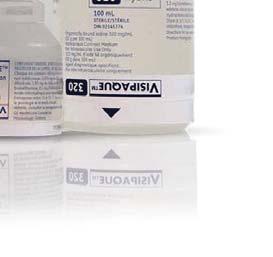

INSIDE:
Smartwatch tracks HF
Researchers at University Health Network, in Toronto, are evaluating whether Apple Watches can be used to effectively monitor HF patients and to predict outcomes.
Page 4
Choosing an AI scribe?
Ontario authorities, including OntarioMD, have collaborated to produce a curated list of AI scribes. The list is designed to help physicians as they incorporate AI into workflows.
Page 6
Keys to innovation
The Toyota Mobility Foundation and MaRS accelerator in Toronto partnered to help foster the rise of Canadian healthcare startups.The venture has been so successful that it is now expanding from six companies and adding another 10. Page 12

Dr. Ahmed Aoude demonstrates how a surgical robot works at the launch of McGill University Health Centre’s SuPER centre, a first-ofits-kind facility that combines IT and AI experts with topflight surgeons working in a hospital. The goal is to improve the surgical experience for patients and physicians by creating smarter robots that can assist surgeons as they conduct their work. SEE STORY BELOW.
MUHC inaugurates centre for surgical AI and robotics
BY JERRY ZEIDENBERG
MONTREAL – The McGill University Health Centre has launched SuPER – the Surgical Performance Enhancement and Robotics Centre at the Montreal General Hospital.
Its mission is to lead the way in research and development of AI-enabled technologies for surgical training, decision-support systems, robotics, and to become a centre of excellence not just in Canada but worldwide.
The launch is part of MUHC’s $35 million Future of Surgery strategy, an effort to improve procedures and outcomes for patients. The hospital has become a world leader in ERAS – Enhanced Recovery After Surgery – procedures that lead to better results by using best practices before, during and after surgical operations.
Similarly, the work on AI and surgical robotics is a key part of improving the patient experience. AI can help personalize surgical care before, during, and after surgery for each patient, while robot-assisted proce-
dures can reduce the size of incisions and blood loss, leading to fewer infections, less pain and faster recovery times.
With cameras and surgical instruments attached to the ends of robotic arms, surgeons can work more accurately in tiny areas of the body, cutting, ablating, and sewing more efficiently than ever before.
As MUHC’s surgeon in chief, Dr. Liane Feldman, noted: “We are investing in next-
Software and hardware developers are working closely with MUHC’s surgeons.
generation technologies and analytics enabling smarter operative planning, data-driven training and augmented decision-making, helping to make surgery less invasive, safer and more personalized.”
There’s a great deal of excitement about the new SuPER centre, as it’s bringing together leaders in surgery, medical robotics and AI – all in a hospital setting.
For this reason, “SuPER is unique in Canada,” said Dr. Amir Hooshiar, founding director of the SuPER Centre, assistant professor of Surgery, and scientist with the Research Institute of MUHC.
He noted that Montreal is already a centre of excellence in artificial intelligence –with organizations like MILA and Google, as well as universities producing world-class innovations in AI – and it’s also a leader in minimally-invasive and robot-assisted surgeries. It’s combining these skills at the SuPER Centre.
“It’s based right at a major hospital,” Dr. Hooshiar added. “The centre is within walking distance of the operating rooms.”
In this way, SuPER can work closely with surgeons at MUHC, learning how they conduct procedures in abdominal surgery, orthopedics, oncology, cardiology, head and neck surgery, interventional radiology and other areas, and incorporating knowledge into the systems under development.
“We have world leaders in these areas,
MUHC launches Surgical Performance Enhancement and Robotics Centre
and they’re all working with SuPER,” said Dr. Hooshiar.
He noted that SuPER is addressing realworld issues, helping to improve procedures and outcomes by working directly with surgeons. “We’re addressing their needs and working with them to solve clinical problems.”
SuPER is part of the Research Institute of MUHC, and it’s located at the Montreal General Hospital. Already, it employs 20 staff and trainees at postdoctoral, doctoral, and graduate levels and plans to add another 10 trainees in the next six months.
To start up and sustain itself, SuPER is receiving critical support from the Montreal General Hospital Foundation.
It’s also working with industry partners, including Canadian start-ups and multinational companies. “We’re co-developing with industrial partners,” said Dr. Hooshiar. “We’re exchanging knowledge.”
The plan is to licence innovations to companies, so the technologies can reach patients in Canada and around the world.
An immediate focus is the development
of the next generation of surgical robots, called “soft surgical robots”. Dr. Hooshiar explained these are different than traditional robots, which typically are capitalintensive and sport large and rigid arms.
In contrast, “Soft robots are modelled on the trunks of elephants and the arms of the octopus,” he said, explaining these structures are extremely flexible. When miniaturized, they’re able to gain access to many regions of the body that have previously been difficult to reach – such as regions behind the nose, for example.
In this case, surgeons will be able to snake small, soft robots through the nose and mouth, using cameras and instruments on the ends of the devices to conduct procedures, such as removing tumours.
Soft robots also have the ability to enter organs like the heart through major blood vessels, enabling the surgeons using them to conduct procedures with greater adroitness than ever before.
Dr. Hooshiar said different robots are needed for these new types of procedures, while the large robots produced by major vendors like Intuitive, are still extremely useful. In fact, an Intuitive da Vinci robot is
Coming up in CHT
Issue DateFeature ReportFocus Report
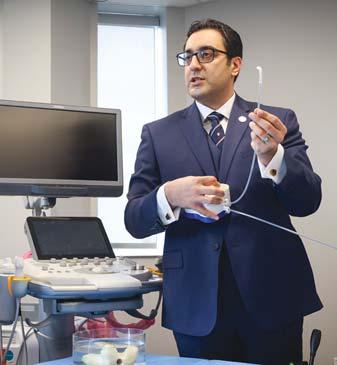
currently located in the SuPER centre, said Dr. Hooshiar, where trainees are using it.
Of course, traditional surgical robots can be very expensive; another goal of the centre is to develop a generation of smaller robots that are more affordable for a greater range of hospitals.
Yet another stream of research at the centre is to develop inexpensive, disposable
robotic devices. “You can mount them, then dispose of them,” he said.
He noted that different solutions are being arrived at by brainstorming with a wide variety of experts at the centre. “We have people with many different backgrounds, and they bring different ways of looking at things,” said Dr. Hooshiar.
The use of AI is a major thrust of the SuPER centre. One way that AI is being used is to model the way that surgeons conduct their procedures so these actions can be adopted by robots.
In this way, new iterations of surgical robots can incorporate the motions, nuances and behaviours of top surgeons, especially those with the best outcomes.
Dr. Hooshiar said that teams at SuPER will work on replicating these behaviours in AI models.
One way they’re doing this is through analyzing video captures of surgical operations, such as hernia repairs. “We have access to thousands of hours of surgical videos,” he said.
AI systems can be trained to model the actions of the surgeons – in hernia repair operations and dozens of other surgical procedures.
March 2026 Hospital at HomeInteroperability
For advertising or editorial inquiries, contact Jerry Zeidenberg, Publisher, jerryz@canhealth.com

Address all correspondence to Canadian Healthcare Technology, 1118 Centre Street, Suite 204, Thornhill ON L4J 7R9 Canada. Telephone: (905) 709-2330. Fax: (905) 709-2258. Internet: www.canhealth.com. E-mail: info2@canhealth.com. Canadian Healthcare Technology will publish eight issues in 2025. Feature schedule and advertising kits available upon request. Canadian Healthcare Technology is sent free of charge to physicians and managers in hospitals, clinics and nursing homes. All others: $67.80 per year ($60 + $7.80 HST). Registration number 899059430 RT. ©2025 by Canadian Healthcare Technology. The content of Canadian Healthcare Technology is subject to copyright. Reproduction in whole or in part without prior written permission is strictly prohibited. Send all requests for permission to Jerry Zeidenberg, Publisher. Publications Mail Agreement No. 40018238. Return undeliverable Canadian addresses to Canadian Healthcare Technology, 1118 Centre Street, Suite 204, Thornhill ON L4J 7R9. E-mail: jerryz@canhealth.com. ISSN 1486-7133
Publisher & Editor
Jerry Zeidenberg jerryz@canhealth.com
Office Manager Neil Zeidenberg neilz@canhealth.com
The knowledge can then be used in education and training systems, so that when medical students and residents conduct virtual operations the AI systems can observe them. “The AI can then tell them, you missed a step or you could have improved in a certain area.”
As well, the actions and behaviours can also be incorporated into surgical robots, so that some of the cognitive load in the OR is taken off the surgeon.
AI can act as an assistant to surgeons in the OR, automatically conducting actions or reminding surgeons of best practices. Moreover, computerized systems never get tired and can help ensure that all the steps in various surgeries have been taken.
Acting as a co-pilot in this way can result in less burnout of clinicians and improved outcomes for patients.
Dr. Hooshiar stressed that we’re a long way from surgical robots actually conducting procedures on their own.
Surgical operations are complex, involving many spur-of-the-moment decisions and collaborations with others in a team.
Human judgement and decision-making abilities are required that are beyond the capabilities of current AI systems – or even those that could be produced in the foreseeable future.
“It’s naïve to think that AI could replace surgeons,” he said. “The goal is to augment their skills in the OR and to improve patient outcomes.”
Contributing Editors
Dianne Craig dcraigcreative@yahoo.ca
Dianne Daniel dianne.l.daniel@gmail.com
Dr. Sunny Malhotra Twitter: @drsunnymalhotra
Norm Tollinsky tollinskyn@gmail.com
Art Director
Walter Caniparoli art@canhealth.com
Digital Media Specialist
Rebecca Downer rebecca@canhealth.com
SuPER’s founding director, Dr. Amir Hooshiar.










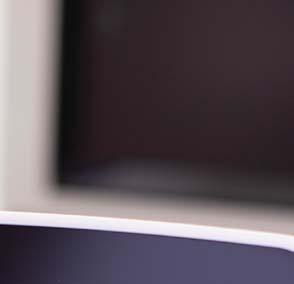



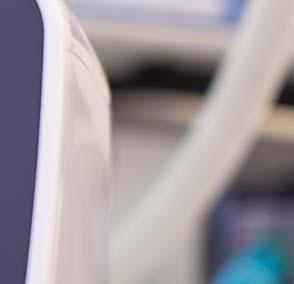







INTRODUCING THE VOLARA SYSTEM

HELP MORE PATIENTS BREATHE EASIER 1
The Volara System promotes accurate, consistent therapy in acute and chronic care settings, and uses Oscillation and Lung Expansion (OLE) technology which has shown improvement in clinical outcomes.1-7



– 3-in-1 therapy: Combines Continuous Positive Expiratory Pressure (CPEP), Continuous High Frequency Oscillation (CHFO) and Nebulizer
– By combining three therapies into one treatment using the Volara System, therapy times can be reduced down to 10 minutes1


– Wide therapeutic pressure range: Allows you to treat a broad range of patients
– Programmable therapy presets: Facilitates standardization of therapy across patient groups
Contact your Baxter representative to learn more at 1-800-267-2337.
References
1. Data on File at Baxter International Inc.



For the safe and proper use of the devices referenced within, refer to intended use, warnings, precautions, and complete instructions for use or the appropriate manual.
2. Huynh TT, Liesching TN, Cereda M, Lei Y, Frazer MJ, Nahouraii MR, Diette GB, Efficacy of Oscillation and Lung Expansion in Reducing Postoperative Pulmonary Complication, JACS (2019).


3. Chasteen,B. C. Becker, M. Wanjala; Respiratory Care, Oscillation Lung Expansion Therapy (OLE) with The MetaNeb System Is Associated with Decreased Hospitalizations for Acute Reactive Airway Disease Exacerbations Compared to Standard Small Volume Nebulizers. OU Health, Oklahoma City, OK, United States, Medical Affairs, Hillrom Inc., Saint Paul, MN, United States.
4. B. C. Becker, K. Piston, Medical Affairs, Evaluation Of Work Of Breathing And Health Care Utilization In Patients Prescribed Daily Oscillation And Lung Expansion (OLE) Therapy At Home. Hillrom, St. Paul, MN, United States, Medical Affairs, Hillrom, Skaneateles Falls, NY, United States.
5. Neil Mushlin, Mwanamisi Wanjala, Carlos Urrea, Kimberly Koloms, Brian Becker (2021, October 17-20) Evaluation of Trends in Patient Reported Outcomes Following Initiation of Oscillation and Lung Expansion Therapy with The Volara System (Poster Presentation). Virtual Meeting, American College of Chest Physicians Annual Meeting. DOI: https://doi.org/10.1016/j.chest.2021.07.1670.
Baxter and Volara are trademarks of Baxter International Inc. or its subsidiaries. CA-FLC188-250002 (v1.0) 04/2025



6. Anwar Hassan, Maree Milross, William Lai, Deepa Shetty, Jennifer Alison, Stephen Huang, Feasibility and safety of intrapulmonary percussive ventilation in spontaneously breathing non-ventilated patients in critical care: A retrospective pilot study. 2021, Vol. 22(2) 111–119.
7. Nyland B, Spilman S, Halub M, et al. A preventative respiratory protocol to identify trauma subjects at risk for respiratory compromise on a general in-patient ward. Respiratory Care. 2016;61(12):1580-1587. Baxter.com



Innovation studio highlights technological solutions for aging-in-place
TORONTO – Most older adults want to stay in their own homes as they age, and technology is key to making this a reality. A new space in downtown Toronto is demonstrating how innovative solutions can support independent living and healthy aging.
In May, AGE-WELL officially opened the AGE-WELL Innovation Studio – an immersive space that brings to life the role of technology and thoughtfully designed environments in enabling people to age in place.
Modelled after a typical one-bedroom apartment, the studio integrates smarthome systems, health monitoring devices, voice integrated personal aides and other cutting-edge technologies to show how they can seamlessly support daily activities and health needs.
Specific features include a smart stove safety device that alerts users or caregivers if the stove is left unattended; a sleep tracker that can detect vital signs and sense when someone gets out of bed, helping monitor sleep patterns and safety; and an exergame that promotes both physical and cognitive health by pairing cycling with scenic videos.
More than just a demonstration space, the studio serves as a hub for innovation, connecting startups, larger companies, researchers, senior living and home care organizations, older adults, caregivers, investors and other partners.
“By providing a platform for companies to showcase brilliant products and connect with key stakeholders, the AGE-WELL Innovation Studio will speed up the adoption of AgeTech innovations that benefit older adults and their caregivers. It’s all about getting these essential solutions into people’s hands,” said Bridgette Murphy, acting CEO, AGE-WELL.
The studio also enables practical testing of AgeTech solutions in a realistic environ-

ment, allowing researchers and developers to collect user feedback and refine their products.
“The real-life setting is crucial, as is direct engagement with older adults and caregivers. Technologies and services must align with the needs and priorities of the people who will actually use them,” said Murphy.
Located at 800 Bay Street, the AGEWELL Innovation Studio was created by AGE-WELL with support from the Faculty of Applied Science & Engineering at the University of Toronto and in partnership with IKEA Toronto Downtown, which provided the furniture; and AGEWELL startups.
AGE-WELL is Canada’s Technology and Aging Network, and a member of the University of Toronto’s Institutional Strategic Initiatives (ISI) program, which supports large-scale interdisciplinary research networks that address grand challenges.
“The Faculty of Applied Science & En-
gineering at the University of Toronto is proud to support the AGE-WELL Innovation Studio. This important addition to Canada’s innovation landscape provides a much-needed space to exhibit advanced technologies and prototypes that support healthy aging.
It offers a valuable platform for University of Toronto researchers and entrepreneurs –as well as innovators from across Canada and beyond –to exhibit their innovations and connect with partners who can help bring these solutions to the people who need them most,” said Dr. Chris Yip, dean, Faculty of Applied Science & Engineering, University of Toronto.
For Paul Lea, an older adult living with vascular dementia, technology has already made a meaningful difference in his daily life. “Smart home devices have given me a sense of security and independence. I can control my lights with my voice. My door locks automatically if I forget to lock it. I
have an app that reminds me when it’s time to take my medications. I’m glad there’s a place like the AGE-WELL Innovation Studio that shows how technology can support older people to live safely and independently at home.”
Designing for independence: “At IKEA, we believe that a well-designed home can significantly enhance the quality of life for everyone, including older adults,” said Arnar Eidskrem, market manager, IKEA Toronto Downtown.
“Our collaboration with AGE-WELL is a testament to our commitment in creating functional and beautiful spaces that support independent living. By integrating our thoughtfully designed, affordable furniture, we aim to demonstrate how older adults can live independently and comfortably in their own homes.”
The AGE-WELL Innovation Studio will also function as an educational space, offering training sessions for students, caregivers and professionals in the field of aging and technology.
“Our ultimate goal is to enable older adults to live independently for longer and enhance their quality of life while fostering collaboration between researchers, companies, and the community,” said Dr. Alex Mihailidis, academic director, AGE-WELL ISI, and vice-chair, research, AGE-WELL board of directors.
A leading researcher in aging and technology, Dr. Mihailidis has spent decades developing solutions to support older adults and caregivers.
“AGE-WELL has long been a convener in the AgeTech sector, bringing everyone together to drive innovation. Now, we have a physical space where innovators can showcase solutions directly to potential users, accelerating the uptake of existing technologies and advancing new innovations.”
UHN tests whether smartwatches can predict heart-failure outcomes
BY JERRY ZEIDENBERG
Researchers at Toronto’s University Health Network are midway through a groundbreaking study that is evaluating whether heart-failure patients can use Apple Watches instead of a cardiopulmonary exercise test (CPET) – specialized treadmills or bicycles based in medical facilities – to determine whether their condition is deteriorating.
Additionally, researchers are applying AI to the data they’re collecting to predict whether patients are getting better or worse.
The innovative watches can measure heart rate and blood oxygen levels –which is essentially what the exercise machines are doing when patients go to a clinic and are put on the treadmill with various leads attached to their bodies.
However, the Apple Watches have some major benefits. First, they can measure heart rate and blood oxygen levels continuously over a long period of
time. Second, for many patients, it’s much more convenient to wear the watch than to go to a clinic.
“CPET is the gold standard, but it’s under-utilized,” said Chris McIntosh, PhD, a scientist at UHN’s Peter Munk Cardiac Centre who is a co-investigator in the study. He also heads his own lab researching applications of AI in healthcare.
“If you live in Toronto, you have a lot of access to CPET,” he asserted. “It involves a lot of expensive equipment and specialized staff. But if you live in northern Canada or rural areas, it’s difficult to get to. People aren’t going to get on a plane or take a long drive to go for a CPET test.”
Using a smart medical wearable, like the Apple Watch, could mean that the playing field is leveled for patients living in remote areas, as their heart health could be monitored continuously.
For its part, Apple donated the equipment needed to conduct the test –200 Apple Watches, version 6, along with 200 iPhones. The lab at UHN created an app that automatically transfers
data from the watch worn by the patient to his or her iPhone; that data is then sent on to the lab.
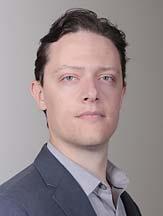
Measurements are automatically performed every six or seven minutes, and the data is analyzed using AI. Dr. McIntosh noted that he and his lab have created their own large-language model to apply to the study and decipher the results. The study has produced a massive quantity of data, as heart rates, blood oxygen readings and ECGs are all picked up by the watches many times each day. That has led to the collection of “terabytes of data”, he said.
Dr. McIntosh observed that Deep Learning techniques have lately become extremely effective and they’ve been very useful when it comes to interpreting the results and making predictions.
At the start of the study, a CPET test was conducted on each of the patients to establish a baseline. During the test, the patient is encouraged to reach their maximum exercise level, to determine their maximum level of blood oxygen. The test is repeated after three months, the duration of the trial for each patient.
During the course of the three-month trial, patients are asked to perform various exercises, to test their abilities.
The project began in 2020, and Apple CEO Tim Cook was so excited about it that he tweeted to his network at the time. The study is led by Dr. Heather Ross, who is also the head of cardiology at UHN and a professor of medicine at the University of Toronto.
The team now has preliminary results and has submitted a paper to a leading journal; it is currently being reviewed.
Dr. McIntosh said he was unable to discuss the actual results before publication.
He noted that the 200 patients who were evaluated were in various stages
Dr. Chris McIntosh
NAEOTOM Alpha® with Quantum Technology CT redefined.






The world’s first photon-counting CT
NAEOTOM Alpha with Quantum Technology, the world’s first photon-counting CT, is nothing less than the reinvention of computed tomography.
Based on the revolutionary direct signal conversion of its QuantaMax detector, NAEOTOM Alpha offers high-resolution images at minimal dose, spectral information in every scan, and improved contrast at lower noise.












Benefit from a range of clinical options and breakthrough consistency never seen before in conventional CT scanners – for potentially scanning previously excluded patients and confident clinical-decision making.
siemens-healthineers.ca/NAEOTOM-Alpha
Scan to learn more
Courtesy of Erasmus Medical Center, Rotterdam, The Netherlands
AI scribe Vendor of Record (VOR) program created for Ontario doctors
TORONTO – Supply Ontario has established a new Vendor of Record (VOR) arrangement for Artificial Intelligence solutions – AI Scribe. This arrangement includes multiple vendors who have been pre-qualified through a competitive Request for Bids (RFB) process.
“The VOR list isn’t just a vendor directory – it’s a curated selection built around real-world clinical needs, privacy and security standards, and regulatory requirements,” said Dr. Chandi Chandrasena, chief medical officer, OntarioMD and a family physician.
“Every criterion, from documentation accuracy to workflow fit, was developed in collaboration with primary care physicians and incorporated input from the Ontario Medical Association, Section of General and Family Physicians, and our AI Scribe Evaluation Study.”
The AI scribe VOR is part of the Ontario AI Scribe Program, Ontario’s broader initiative to promote the responsible and effective adoption of digital health technologies and to assist healthcare providers. This program was developed in partnership with key organizations, including the Ministry of Health, Ontario Health, and OntarioMD.
The VOR arrangement, which is effective from April 27, 2025 through to April 27, 2028, is for a term of three years, with one additional optional extension term of one year. The VOR arrangement is optionally available to non-OPS entities including entities in public healthcare sector.
This VOR arrangement will introduce a digital tool designed to reduce the administrative burden on healthcare practitioners, allowing them to focus more on patient care. This will enhance patient engagement, improve care coordination, and optimize clinical workflows.

Right now, no funding is available to acquire solutions from this VOR list. “In a recent physician forum, many acknowledged that while funding is important, privacy, security, and liability alignment come first,” said Dr. Chandrasena. “Through the VOR list, we will have group-buying power to ensure prices are fair and better than market prices.”
Qualified vendors. There are currently
20 AI Scribe Vendors of Record:
•12677776 Canada Ltd./EMERGE Healthcare Co.
•3M Healthcare Canada Company
Limited (DBA Solventum)
•4530019 Nova Scotia Limited, dba SpeechMD Voice Recognition
•ADGTECH SOLUTIONS INC.
•Aya Health Technologies Inc.
•Laboratoire CoeurWay Inc.
•Data Centre Intelligence Inc.
•Deljoo Inc.
•DocSplain AI Doctor Inc.
•8137862 Canada Inc. (O/A MarkiTech)
•MediEmma AI Software Services Inc.
(doing business as Empathia AI)
•Pippen AI Corporation
•QuickChart Inc.
•Scribeberry Ltd.
•Scrubs Co-Pilot Inc.
•SinaAI Inc.
•11855760 Canada Inc. (Tali AI)
•Vero Scribe, 1001079684 Ontario Inc.
•Mikata Health Inc.
•Mutuo Health Solutions Inc.
Transcription: The solutions must provide near-instant transcription (within 30 seconds) of the patient-clinician conversations. The solution should also have features to pause/resume without data loss, filter out background noise and irrelevant content, and differentiate multiple speakers (e.g. patient, caregiver, clinician).
Note creation & editing: The solution must be able to automatically generate detailed, high-quality notes reflecting the full
patient visit, while adhering to CPSO documentation standards. Clinicians must be able to review/edit these notes within the platform using typing or voice dictation, ensuring accuracy, completeness, and control over final notes.
Templates: The solution should offer a range of structured note templates such as SOAP, referral, consult, and summary formats. Clinicians will be able to customize existing templates or create their own and have the flexibility to switch between templates mid-session without losing previously captured data.
Language capabilities: The solution must accurately transcribe and generate notes in English and be able to process diverse accents and medical slang and standard clinical acronyms. The solution’s interfacing must be available in English by default. Scribes should also be optionally available in French (and other languages), French-language interfacing may also be offered.,
Patient-facing summaries: The solution should generate patient-friendly visit summaries and care instructions, with the ability to adjust language for different reading levels.
Workflow integration: Clinicians should be able to easily transfer finalized notes into their EMRs. The solution should work on multiple platforms (web, mobile, desktop), and offer offline functionality with automatic sync when connectivity is restored.
Compliance with privacy laws: The solutions must comply with Canadian and Ontario privacy laws, including the Personal Health Information Protection Act (PHIPA), Personal Information Protection and Electronic Documents Act (PIPEDA), and the Freedom of Information and Protection of Privacy Act (FIPPA).
Digital navigators: New kids on the Canadian healthcare block
BY IMAN KASSAM MHI, GILLIAN STRUDWICK, PHD, AND SEAN KIDD, PHD
Canadians are utilizing digital health tools more than ever.
Healthcare organizations across the country are integrating digital tools to enhance the services they provide, making it easier for individuals to access and manage their care.
A 2023 survey by Canada Health Infoway found that 80 percent of Canadians have accessed their health information electronically, while 60 percent have used mobile apps to support their wellbeing over the past year.
From patient portals and virtual care platforms to mobile health apps, digital solutions are becoming an essential part of the Canadian healthcare system – reshaping how patients engage with clinicians and access their health information.
Despite their undeniable benefits, digital technologies present challenges for healthcare systems, clinicians, and patients alike. The implementation and integration of these tools can be complex,
and their widespread adoption is not without barriers. Perhaps the most pressing concern is the growing digital divide.
While significant progress has been made in expanding broadband internet access across Canada, patients and clinicians still struggle to make use of these digital resources, with digital literacy remaining a critical issue. Many individuals lack the skills to navigate digital tools, interpret health data, or effectively use the tools available to them.
A 2025 survey conducted by the New England Journal of Medicine found that 70 percent of international health system leaders identified low digital literacy among patients as the largest hurdle to implementing virtual care services.
To address this gap, a new role is emerging within healthcare: the digital navigator (sometimes referred to as a digital or technology coach). While not a completely new concept, digital navigators enable the use of patient-facing digital technologies in clinical care. They differ from clinical informatics or IT specialists in that their sole focus is to support clinicians and patients in best uti-
lizing patient-facing digital tools to support care rather than providing technology support for enterprise clinical information systems (i.e., electronic health records).
As a member of the clinical team, they can play a crucial role in supporting clinicians and patients in integrating digital tools into care. Some examples of
NEJM study: 70% of health system leaders say low digital literacy is the biggest hurdle to virtual care.
the support digital navigators can provide include:
•Identifying evidence-based digital tools tailored to a given clinical need.
•Supporting patients in building and developing digital literacy skills.
•Troubleshooting technical issues that may arise.
•Helping both patients and clinicians interpret and make use of digital health data.
One of the greatest strengths of the dig-
ital navigator is the adaptability and flexibility of the role. Digital navigators can be embedded into various clinical settings, supporting a wide range of digital health technologies and patient populations.
However, despite the potential of digital navigators, the role is still in its early stages of implementation. International health systems such as the United States, Australia, and Germany have begun piloting digital navigator programs, but largescale implementations are yet to unfold.
Within the Canadian sphere, the implementation of digital navigators has been limited.
Recently, London Health Sciences Centre and St. Joseph’s Healthcare in London, Ontario, implemented a digital navigator program to support patients in accessing and using virtual care services. Patients accessing care at the hospital and within the community can receive technical and tailored support in learning how to navigate the video-conferencing platform they use to provide virtual care. While this signals a positive shift in the way patients are provided support












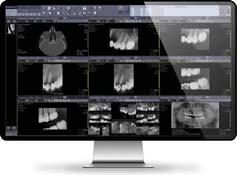



Centralized patient scheduling makes appointments easier for patients
BY EMILY SANTOS
Scarborough Health Network (SHN) is delivering a superior experience for patients accessing healthcare services, right from the start of their hospital journey.
Thanks to a new centralized patient scheduling model implemented last spring, which works in tandem with an efficient registration process, SHN now operates the largest volume of centralized patient access interactions in Ontario – daily booking over 1,400 appointments and registering more than 3,000 patients across three hospitals and several communitybased locations.
The organization-wide move to improve patient access began with SHN’s adoption of the Epic clinical information system in December 2021. Now equipped with fully electronic health records, SHN was able to centralize Patient Registration at its Birchmount, Centenary, and General hospitals, each supported by self-serve registration kiosks.
The next step was to centralize a complex labyrinth of clinic schedules spread across more than 150 outpatient areas. SHN’s patient contact centre is a one-stop shop for booking, rescheduling, canceling, or inquiring about appointments through a single point of contact.
It consistently scores 85 percent or higher for patient satisfaction, due to exceptional customer service and accessibility, including extended operating hours on evenings and weekends.
Patients are offered the earliest available

appointments with coordination across multiple clinics (if applicable), so they can spend less time waiting on the phone and select the clinic location that is closest to their home.
On arrival at the hospital, up to 90 percent of patients are completing their check-in at kiosks in under a minute, a significant improvement from the previous average of over eight minutes.
For patients with multiple appointments on the same day, registration kiosks allow patients to register just once at a central location, instead of repeating the process at each clinic. The kiosks are supported by staff who assist, answer questions, and help direct people to their appointments.
“When patients can easily book appointments, they are more likely to seek timely medical care, leading to earlier diagnosis and treatment of conditions,” said Tobi Odueke, director of patient access at SHN.
“Our booking and registration systems are strategically designed to break down barriers, making it easier for patients of all demographics and abilities to schedule and attend their appointments with ease and convenience.”
For example, Patient Access Scheduling representatives are able to communicate with patients in their preferred language using interpretation services, as well as schedule an interpreter for their hospital visit.
They can even help to reserve a volun-
teer if a patient needs on-site assistance when visiting the hospital, through the Call Ahead for Volunteer Assistance program.
“I treat every patient as if they were one of my family members; I love to go above and beyond to make patients feel important and comfortable, and build trust,” added Sarah Cowal, patient access scheduling representative.
“I work to find solutions by coordinating multiple appointments on a single day to save them time, money, and stress. I also work closely with doctors and technologists to accommodate patients’ cultural and personal preferences, such as offering the option of a female-only staff.”
Grounded in SHN’s commitment to provide the best possible patient experience, the network’s strategic centralization of patient access functions enabled by Epic also resulted in millions of dollars in annualized savings – funds that are being reinvested into clinical areas in support of exceptional quality care.
Looking ahead, the Patient Access Team will focus on making additional improvements to the appointment booking and registration processes, seeking input from patients and conducting health equity analyses.
With upcoming technology enhancements, patients will soon be able to schedule their hospital appointments online or through Epic’s patient portal, MyChart, a free, secure tool to view and share personal health information at any hospital across the Central East region of Ontario.
Emily Santos is a Communications Officer with the Scarborough Health Network.
AI in Canadian healthcare: Balancing oversight and innovation
BY LAURIE LAFLEUR AND SHIRLEY FENTON
Artificial intelligence (AI) is a game changing technology that has the potential to significantly impact the quality, scalability, and cost of healthcare services in Canada. However, as adoption accelerates, so too does the need for regulatory oversight to ensure safety, efficacy, and ethical use.
The challenge? Governments worldwide are taking different approaches to AI governance, creating a complex web of policies that healthcare organizations and developers must navigate.
So, where does Canada fit into the mix? In this article, we’ll explore how global regulations impact AI adoption in Canadian healthcare, and the roles that policymakers, regulators, and industry leaders play in shaping its future.
Global AI policy trends: As AI regulations evolve worldwide, three major players are leading the charge, each with a distinct approach that impacts healthcare AI deployment.
•European Union: With the landmark AI Act, the EU is taking a risk-based approach, classifying AI applications based on potential harm. High-risk systems, like AI-powered diagnostics and clinical decision support, face strict require-
ments for transparency, data security, and human oversight. For AI developers considering the EU market, compliance will be a must.
•United Kingdom: The UK has opted for a lighter, principles-based approach, emphasizing innovation and safety without imposing rigid federal laws. Programs like the NHS AI Lab are exploring regulatory sandboxes to safely test AI in clinical settings before full-scale deployment.
•United States: The new administration is introducing policies aimed at reducing regulatory barriers for AI innovation, shifting towards an industry and sector-specific approach to regulation and risk management. Meanwhile, the Food and Drug Administration (FDA) is refining its oversight of AI-powered medical devices, with a focus on realworld performance monitoring and adaptive learning algorithms.
Canada’s AI policy landscape: Policymakers and regulators in Canada are striving to balance regulatory oversight with support for innovation. However, with healthcare policy largely falling under provincial jurisdiction, AI regulation is shaping up to be a patchwork effort.
•Federal Level: The Artificial Intelligence and Data Act (AIDA), part of proposed Bill C-27, sought to introduce
risk-based AI regulation. While not healthcare-specific, the proposed AIDA could influence how AI is deployed in clinical settings, particularly as it relates to transparency and accountability.
Provincial efforts:
•Ontario: Home to the Vector Institute, Ontario is advancing AI in digital health, while regulatory bodies are as-


sessing best practices for AI in clinical decision-making.
•Quebec: A leader in AI ethics, Quebec has adopted governance frameworks focused on responsible AI use.
•Alberta: Strong health data policies are positioning Alberta as a hub for AI-driven precision medicine and predictive analytics.
Unlike the EU’s top-down approach,
Canada’s decentralized healthcare system requires collaboration between federal and provincial authorities to create a unified AI regulatory framework. Who else is shaping AI policy in Canadian healthcare? AI regulation isn’t just a government effort – it’s shaped by a network of regulators, industry leaders, and research institutions, all working toward a framework that aligns with principles of trustworthy AI:
•Health Canada: The primary regulatory body overseeing AI-driven medical devices, Health Canada collaborated with the US FDA and the UK Medicines and Healthcare products Regulatory Agency (MHRA) to define the Good Machine Learning Practice for Medical Device Development, which defines best practices for data quality, bias mitigation, and realworld performance monitoring. Additionally, Health Canada is exploring new pre-market guidance for machine learning enabled medical devices (AI systems that evolve based on new learning) to ensure they maintain accuracy and reliability throughout their lifecycle.
•Office of the Privacy Commissioner: With healthcare AI relying heavily on patient data, the Privacy Commissioner plays a crucial role in setting data
Laurie Lafleur
Shirley Fenton











How AI is helping enable a new generation of smart prosthetic limbs
BY SCOTT LILWALL
Tucked away in a laboratory on the University of Alberta (U of A) campus, in a space crammed full of detachable hands and robotic parts, a team of researchers is working on the next generation of smart prosthetic limbs that combine groundbreaking advancements in robotics and artificial intelligence.
“This is one thing I love about this line of research: it is centered on the individual,” said Dr. Patrick Pilarski, one of the co-leads of the Bionic Limbs for Improved Natural Control Lab (BLINC).
“We work really hard on building new AI technologies that allow a device to sculpt itself to a person and what they need,” he said.
Pilarski, in partnership with lab director and fellow U of A professor Dr. Jacqueline S. Hebert, MD, leads an interdisciplinary team of nearly two dozen researchers, with expertise ranging from artificial intelligence, rehabilitation medicine, prosthetics, kinesiology, robotics, and biomedical engineering.
Their research seeks to better understand how human beings approach motor tasks and use this knowledge to help develop a new generation of AI-enabled prosthetic limbs that more easily adapt to the needs and desires of the people who use them.
“The common perspective on artificial limbs is that they’re a tool and that a person has to learn to use that tool,” said Pilarski, who is also a Fellow with the Alberta Machine Intelligence Institute (Amii) and a Canada AI Chair with the Canadian Institute for Advanced Research (CIFAR).
“Here at the BLINC Lab … [we] believe the tool should also learn about the per-
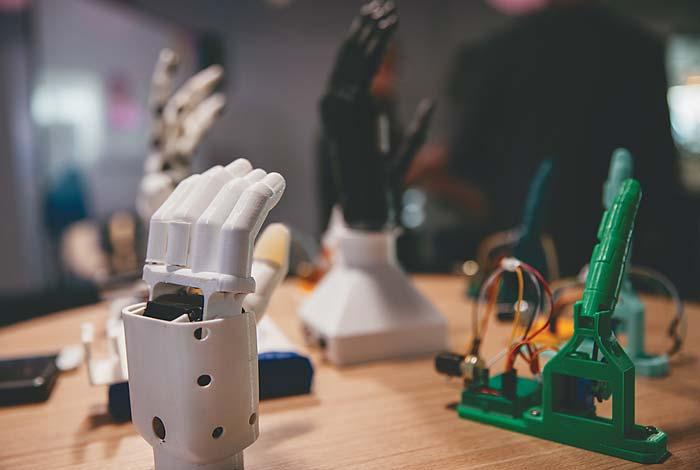
son, and that it should adapt and change and improve as the person uses it during their daily life.”
Learning from experience: The last few decades have seen impressive advancements in prosthetic limb technology – robotic and sensor technology have made artificial limbs that move more naturally and fluidly, while new materials allow devices to be more durable and lightweight. But Pilarski said even as limbs have become more sophisticated, they can still be difficult for the person using them to control.
For example, BLINC Lab is using machine intelligence to develop bionic limbs with adaptive switching.
Imagine the movements needed to pick a glass up off the table. For a person using a natural limb, the movement would prob-
ably be done in one fluid motion. However, someone using a robotic upper limb prosthesis, in many cases, has to toggle their device’s joints one at a time.
So, they might have to first extend the limb’s elbow joint to reach toward the glass, then switch to the wrist motor to get the hand aligned. Switch modes again to open up their hand and then close it around the glass. And then go through the whole process again in reverse to lift the glass up.
This kind of toggling can be done in different ways: some limbs might use onboard switches or buttons, while others can be activated by the user contracting certain muscles where the limb is attached. But no matter what control system is used, this kind of toggling can be time-consuming and frustrating.
Reinforcement learning is one of the key tools that the BLINC researchers are using to build better control for prosthetics. This branch of machine learning allows devices to learn from trial-and-error experience, in much the same way that people do.
By using reinforcement learning to train the system that controls the arm, Pilarski explains that the device will eventually learn from the person using it and make predictions on what kinds of movements the person is trying to achieve.
With those predictions, it can do the mode-switching automatically (although the user would be able to manually set the mode if the prediction was wrong.)
The result? Prosthetic limbs are more intuitive, work faster, and are tailored to the specific needs and the movements of the person who is using them.
Their work in RL has also allowed people to train their bionic limb on other movements and actions, and then have the prosthesis learn to mirror that in response to the signals they give it. They’ve explored how this approach could be used for other assistive medical devices, including controlling motorized wheelchairs and exoskeletons.
“It’s actually almost like a translator,” Pilarski said. “Learning and adapting to how the person expresses themselves through their body. Then mapping that to make it feel like it’s part of their body and doing what they’re hoping it’s going to do.”
The work at BLINC Lab is supported through a partnership between Amii (a global centre for reinforcement learning research), the University of Alberta, and Edmonton’s Glenrose Rehabilitation Hospital. Human-centred AI: This past October, the BLINC Lab highlighted what their re-
Thank you, Steve: Digital Health Canada celebrates its 50th anniversary
BY SHELAGH MALONEY
We are all part of one of the most complex of industries –the delivery of healthcare. To facilitate the objectives of COACH it is not only necessary to recognize the complexity of our industry, but indeed, to utilize that complexity by ensuring that the components – hospitals, governments, insurers, and professional associations – play a vital role in COACH. It is also essential to have a viable contribution from all the facets which make up our industry’s components. If the process of learning is to be meaningful, it is essential to have a contribution not only from the data processors, but also from the administrators and the medical and paramedical professionals. These words were written in 1975 by Steve Huesing, Founding President of Digital Health Canada (then known as COACH–The Canadian Organization for the Advancement of Computers in Health). Although some words may be dated (when was the last time you heard the term ‘data processor’?), the sentiment holds true 50 years later.
If the process of learning is to be meaningful, all parties who have a stake in the game need to be at the table.
This has been, and will forever be, Digital Health Canada’s superpower. We are a strong, vibrant community of over 7,500 professionals from across the country. We are clinicians, administrators, industry representatives, start-ups, governments, researchers, academics, students, patients, and associations.
Each one of us has a unique perspective and important insights to share and, together, we are advancing the digital health agenda in Canada. Digital Health Canada members are committed to learn, share and evolve.
I can’t help but wonder what Steve would think about his legacy. I expect he may feel the way many of us do – excited and energized by the innovations that are happening in the field today… and frustrated by the lack of progress and the inability to scale.
Reflect on the recent e-Health Conference to understand what I mean.
e-Health, co-hosted by Canada Health Infoway, Canadian Institute for Health Information, and Digital Health Canada,
is the biggest digital health gathering in the country.
At e-Health25 there was a sold-out exhibit floor, more sponsors than ever before, and so many delegates that a wait list was initiated. From the opening plenary to the closing keynote, presenters shared how they are changing the face of healthcare in Canada.
We learned how AI is being used in very innovative ways to enhance diagnostic ability, provide more personalized
If the process of learning is to be meaningful, all parties with a stake in the game need to be at the table.
care, assist with patient navigation, and address equity issues. We heard about cybersecurity, digital twins, and bots. Innovations that Steve likely couldn’t have imagined – or at least imagined being available in 2025.
Now for the ‘frustrated’ part: impact and adoption have not kept up with the pace of change. The opening plenary at
the conference was titled Is Data Failing Tech in Canada? and featured a discussion about the state of access to data, quality, governance, and literacy. All areas where there is still work to do.
Digital Health Canada’s 50th anniversary theme is: Celebrate today. Create tomorrow. We can create a tomorrow where care is more seamless, more efficient, and more personalized. A tomorrow where care is accessible to everyone regardless of location, ethnicity, or gender affiliation. That’s the power of digital health. I’ll close by sharing Steve’s final words from his inaugural membership newsletter. “We hope that COACH can serve as a focal point for the process of sharing our thoughts and learning from one another.”
Mission accomplished, Steve. Digital Health Canada, powered by the amazing people who have been part of this journey, is ready to help shape the next 50 years, and beyond. Together, let’s create tomorrow!
Shelagh Maloney is the CEO of Digital Health Canada, a member-supported notfor-profit professional association.
Focus on care, not on your technology



Of all the things that demand attention in your healthcare facility, your technology shouldn’t be one of them.

Eaton’s Tripp Lite series selection includes solutions patient care vicinity.







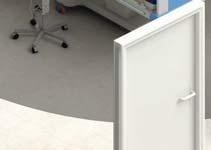



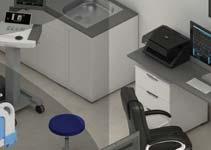




*To promote a healthier environment for patients and staff, Safe-IT™ antimicrobial and antibacterial options are available for select models.



Medical-grade surge protectors & power strips*

Medical-grade hospital cart power supplies

TV/monitor mounts

Medical-grade UPS systems*

Medical-grade isolation transformers

Antibacterial cables*



Wall-mount enclosures

Hospital-grade UV charging carts
Mobility start-ups work with MaRS and Toyota to fuel their expansion
BY JERRY ZEIDENBERG
TORONTO – Start-ups in the healthcare sector often find that no company is an island – it takes partnerships and collaboration to launch and grow. That’s been the experience of many participants working with the Toyota Mobility Foundation and the MaRS Discovery District.
Toyota and MaRS have been nurturing a cohort of six small companies in the health mobility sector, creating the ‘Mobility Unlimited Hub’. The project has been so successful, they’re adding 10 more companies this year.
The current cohort includes the following companies:
• Axtion Independence Mobility Inc., which launched pre-orders in the U.S. and Canada for the RAYMEX Lift after receiving its establishment registration and device listing from the US FDA and its Medical Device Establishment License from Health Canada earlier this year.
• Braze Mobility Inc., a company producing blind-spot sensors for wheelchairs. The sensors automatically detect obstacles, enabling users to avoid collisions – saving themselves from injury and embarrassment. Braze has received two patents, helping them expand into Europe and scale in the U.S.
• Trexo Robotics Inc., which devised a robotic exoskeleton that helps kids with disabilities walk at home or in their neighborhoods. Its users have now surpassed 100 million steps.
• AWL-Electricity showcased its wireless charging solution, the Agile Station, at the Paris Para games in partnership with WHILL France, accelerating their entry into international markets.
• Deaf AI trains machines with AI to do sign language to make the real-world more
inclusive for people who only communicate in sign language. The company secured key partnerships, including with the Kanata North Business Association, as well as international speaking engagements.
• Cheelcare is raising $3.5 million and will be publicly listed on the TSX Venture Exchange following its reverse takeover of Departure Bay Capital Corp. The company produces advanced wheelchairs and other products for the rehab mobility market.
“Our partnership with Toyota and MaRS has been a game-changing experience,” said Tracey McGillivray, CEO of Axtion Independence Mobility, a maker of a chair-like lift that helps people get up after falling and also prevents falls.
Called the RAYMEX Lift, the device functions as a portable walker and helps seniors get around and carry out their daily tasks. But in the event of a fall, a platform can be button-activated and lowered to the ground.
The person who fell can shimmy onto the platform, and the platform will raise them to a sitting position.
From there, if they wish, they can use hand supports to raise themselves to a standing position.
The device can also be used by people to stabilize themselves when in a sitting position, to prevent falls when they’re trying to get up.
It’s a unique product, and it has been in development since 2019, when McGillivray decided to create a device to solve the problem of people who are immobilized by falls.
She was inspired by her own father, who began experiencing falls at that time.
With an engineer partner, Liam Maaskant, along with her orthopedic surgeon brother and a team of skilled employees, Axtion began to produce a series
of prototypes. It’s the sixth prototype that’s being marketed, beginning this year.
Not only is the RAYMEX Lift helpful for patients, but it’s also extremely useful for hospital workers. When attempting to lift patients off the floor, many of them injure themselves – resulting in time off work and
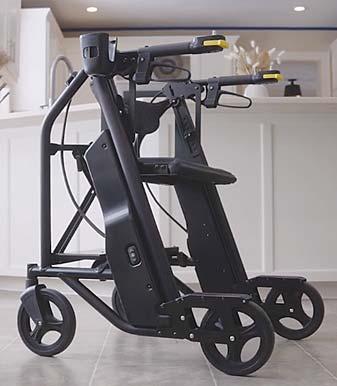
significant costs to the healthcare system.
The National Institutes of Health (NIH) in the U.S. estimates that there are up to one million falls per year in US hospitals each year. The falls affect both patients and the healthcare workers attempting to help them, as injuries – such as back strain and pulled muscles – from lifting fallen patients are quite common.
The partnership with MaRS and the Toyota Mobility Foundation has been instrumental to the company’s success, said McGillivray. They received seed funding of $50,000, which she said was a significant help in getting things off the ground and creating momentum.
Axtion and five other Canadian mobility start-ups in the program will each receive another $50,000 this year in renewed support; moreover, the program is expanding, and 10 more participants will receive $100,000 each as they participate in a two-year program.
Toyota also helped Axtion enter the Japanese marketplace, where the company is working to sign a licensee to manufacture and distribute in Japan and other parts of Asia.
McGillivray noted that being part of the group has been invaluable, as the partners have shared valuable knowledge.
“The other companies have been at it a little longer than us, and they’ve been generous in sharing their expertise,” said McGillivray. In particular, they helped her understand the process for regulatory documentation in the United States, helping Axtion to move ahead with its plans there.
Based in Nova Scotia, the RAYMEX Lift team worked out of Dalhousie University’s Emera ideaHUB, where it developed its initial prototypes. McGillivray notes that partners in Atlantic Canada were also critical to the development of the lift.
The RAYMEX Lift will sell for about $5,500 – that includes hardware, software and its power system. McGillivray said the price is comparable to a power wheelchair and many other lifts on the market.
Moreover, the innovation doesn’t stop. The company will soon combine the functions of lift and wheelchair – a product that it’s coming out with next year.
And it has an even more advanced project in the works, an autonomous lift that can come to the assistance of a person who has fallen. It can be activated by a watch or pendant. “If you fall, and you need help, it can come to you,” said McGillivray.
Advancing connected care through innovation that works
BY DAREK SZADKOWSKI
Canada’s health system is evolving, shaped by new technologies, shifting needs, and a growing demand for more connected, patientcentered care.
At the heart of this evolution is the recognition that access to information, by patients, clinicians, and health system leaders, is essential to improving care experiences and outcomes.
But even as digital tools become more common in clinical environments and pan-Canadian standards evolve, challenges remain, particularly around adoption of these tools and their fit within clinical workflows. These challenges often result in increased administrative burden and missed opportunities to deliver more coordinated care.
The question we face now is not whether innovation is needed, but how we can support it in ways that are practical, scalable, and grounded in the realities of care delivery. It was in the context
of these challenges that Infoway’s Vendor Innovation Program was conceived.
The Vendor Innovation Program seeks to identify and support clinical implementation of real-world solutions that align with national interoperability goals. The most recent cohort of selected projects reflects the diversity of Canada’s health system, spanning primary care, acute care, and rural and Indigenous contexts, and demonstrates how innovation can be applied thoughtfully to address persistent challenges.
Across these projects, we see common themes: improving access to standardized health information, reducing documentation and administrative workload, and supporting clinicians with tools that enhance decision-making at the point of care. Many initiatives are using artificial intelligence to convert the vast amount of unstructured data in EMRs into usable formats or leveraged to automate routine processes, helping providers spend more time with patients and less on paperwork.
As a requirement of the Vendor Inno-
vation Program, innovations are being tested and deployed in clinical environments, with active engagement from vendors, care providers, and jurisdictional partners. This ensures that the innovation is proven and shaped by realworld conditions.
By focusing on implementation and usability, initiatives like these contribute
The projects were selected on technical merit and for their expected impact on Canada’s digital health priorities.
directly to the foundational work of building a more connected health system, where data is portable, workflows are more efficient, and patients and providers alike are better supported by the tools at their disposal. We are proud to announce that the 2025 Vendor Innovation Program recipients are:
• Ava Industries Ltd.
• Intrahealth
• OceanMD
• Okaki Health Intelligence Inc.
• Pentavere Research Group Inc.
• ResolveHD
• SRA Academy
• Verto Inc.
The projects were selected not only for their technical merit, but also for their demonstrated potential to deliver real, lasting impact on Canada’s digital health priorities. Each initiative will be deployed in live clinical environments, providing tangible value to patients, clinicians, and health system leaders.
At Infoway, our focus is on enabling this kind of meaningful progress. Whether it’s supporting early-stage ideas or scaling proven approaches, we are working to ensure that innovation delivers real value by connecting people to their health information, improving provider workflows, and strengthening the continuity of care.
Darek Szadkowski is Senior Director of Product Management & Vendor Operations, Canada Health Infoway.
Canadian innovation: the RAYMEX Lift.

BC Cancer rolls out photon-counting CT scanner, a leap in technology
VANCOUVER – People in the province with cancer now have access to Canada’s most advanced CT scanner. The new scanner, installed and operational at BC Cancer – Vancouver, uses leading-edge photon-counting technology to deliver more accurate imaging with less radiation exposure to patients.
“B.C. is once again leading the nation in integrating transformative medical technology and tools, helping to achieve better health outcomes and save lives,” said Josie Osborne, minister of health. “This first-inCanada CT scanner is a significant milestone in our 10-year cancer action plan. By delivering more precise diagnostic imaging while reducing radiation exposure, we are improving cancer care and supporting people to live fuller, healthier lives – during cancer and beyond.”
Diagnostic imaging is a crucial component in a patient’s cancer journey, providing healthcare teams with the critical information they need for an accurate diagnosis and to create an effective and personalized treatment plan.
Compared to conventional CT scanners, photon-counting CT scanners deliver a higher resolution image with less radiation.
This new technology provides much

Photon-counting CT is said to be a game-changer, and this is the first deployment in a Canadian centre.
more detailed information about a patient’s organs and tissues, enabling radiologists to visualize minute details with exceptional clarity.
“This first-in-Canada scanner is just one example of how, through B.C.’s 10Year Cancer Action Plan, we are integrating leading-edge technology and the latest
innovations to improve the experience of our patients and help them to live the bestpossible lives with and beyond cancer,” said Dr. Kim Chi, executive vice-president and chief medical officer, BC Cancer.
The new scanner at BC Cancer – Vancouver will perform more than 14,000 CT scans annually. It replaces a conventional CT
scanner that had reached the end of its lifespan after being in operation for 12 years.
“It is truly great to see the partnership between BC Cancer, the Provincial Medical Imaging Office and BC Cancer Foundation enable us to bring the most powerful diagnostic CT scanner to the people of B.C.,” said Dr. Maureen O’Donnell, executive vice-president, provincial clinical policy, planning and partnerships, Provincial Health Services Authority. “This was truly a team effort from our frontline diagnostic imaging staff and everyone involved.”
The total project cost was $6 million, with $3 million provided by the BC Cancer Foundation and $3 million from the province. BC Cancer Foundation’s contribution was fully funded by the Leon Judah Blackmore Foundation.
“The BC Cancer Foundation is proud to invest in groundbreaking technology –like this first-in-Canada scanner – that will save lives,” said Sarah Roth, president & CEO, BC Cancer Foundation.
B.C.’s 10-Year Cancer Action Plan outlines steps to better prevent, detect and treat cancers and deliver improved care, while preparing for growing needs, including building more cancer centres in B.C., adding new diagnostic equipment, hiring new physicians and clinical support staff and expanding cancer screening programs.
MIIT returns in 2025, highlights AI, interoperability and patient access
After a five-year hiatus due to COVID-19, MIIT returned in full force. Hosted at Hamilton’s historic Liuna Station –once a bustling CN rail hub, now a stunning neoclassical event venue – the 2025 Medical Imaging Informatics and Teleradiology (MIIT) Conference made a powerful statement: this wasn’t just a technical gathering, but a national pulse-check on how imaging can drive real impact in Canadian healthcare.
It was a prime opportunity to connect, share ideas, and re-energize the community.
Back on track: Dr. David Koff kicked off the day with a compelling analogy: imaging informatics, like freight rail, needs a sturdy infrastructure – built on standardization, interoperability, and orchestration – to deliver on its full potential.
Regional image exchange – A national snapshot: Don Dennison moderated the opening panel on regional image exchange, featuring Jason Nagels, Sandra Colavecchia, Alain Gauvin, and Monief Eid. Despite diverse perspectives, all agreed: Canada’s DIRs (Diagnostic Imaging Repositories) are evolving, consolidating, and facing growing infrastructure demands.
A standout moment came when Eid noted that Saudi Arabia has implemented multi-specialty VNAs – across radiology, cardiology, dentistry, and pathology – serving hundreds of clinics. A reminder of what’s possible with vision and scale.
Cybersecurity – Our Crown Jewels at risk: Pravine Balkaran didn’t sugarcoat the realities. In his session, “Protecting Your Crown Jewels,” he reminded us that healthcare remains the #1 target for ransomware. Imaging systems, often underresourced and under-secured, represent a critical clinical risk, not just an IT problem.
AI roundtable – Substance over hype: Moderated by Brad Genereaux, the AI roundtable brought together Drs. Khan Siddiqui, Alex Bilbily, April Khademi, and Ben Fine for a grounded discussion. The consensus? AI isn’t a silver bullet, it’s a long-term commitment. Key takeaways included Siddiqui’s insights on failure rates, Khademi’s emphasis on explainability, Fine’s real-world implementation lessons, and Bilbily’s candid take on clinician burnout.
Real-world AI – Beyond the buzz: Dr. Nina Kottler’s keynote wasn’t theoretical, it was practical. She showcased real deployments of AI in triage, workflow, and report generation, reinforcing that AI hasn’t replaced radiologists, but has meaningfully augmented their tools. With LLMs and foundation models emerging, she posed a powerful question: “Why wouldn’t we use this?” The answer is obvious.
Patient-centered innovation and smart imaging: Following Dr. Kottler’s talk, Rishi Nayyar, co-founder of PocketHealth, presented on delivering improved patient experiences through AI and image exchange, making images and reports available seamlessly to patients. His presentation
highlighted how to improve outcomes by closing care gaps, increase patient engagement, and support provider efficiency.
Dr. Fadi Aris then shared insights from Montreal’s Lakeshore General Hospital on deploying an AI-powered diagnostic tool designed to support ER clinicians in identifying fractures and joint effusions from radiographs. The tool has been successfully integrated into a highvolume teaching hospital, earning strong support from emergency and orthopedic teams with zero missed fractures.
LLMs – Promise and pitfalls: Dr. Jarron Chong followed with an insightful
MIIT brings diagnostic imaging and IT experts from Canada and the US to brief attendees on new, exciting developments.
and entertaining session: 10 Truths About Large Language and Vision Models. Equal parts myth-busting and reality-check, he emphasized the risks of hallucinations and hype, encouraging thoughtful, cautious adoption.
Standards that matter: Mohannad Hussain unpacked the evolving landscape of standards like FHIR, DICOMweb, and SMART on FHIR. His core message: these aren’t just acronyms, they’re the foundation for everything else.
Interoperability – The real talk: Chaired by David Kwan, the interoperability panel with Kevin O’Donnell and Kinson Ho dove deep into what’s truly
working (and not) in the space. No buzzwords, just honest dialogue about cooperation, vendor alignment, and why standards still too often feel optional.
Bill Wallace and Brad Genereaux highlighted the growing power of the open-source ecosystem. Tools like OHIF, Orthanc, and TotalSegmentator aren’t just side projects, they’re central to how modern imaging systems are being built and scaled.
Human impact – Task shifting in Nunavut: Greg Toffner closed the day with a powerful story of community-driven care. He shared the successful implementation of a radiological training program in Nunavut, empowering locals to become Basic Radiological Technicians and serve their own communities. It wasn’t just a case study but a game changer.
The verdict? MIIT is back, and bolder than ever: This was no soft re-entry. MIIT 2025 tackled cybersecurity, equity, GenAI, standards, burnout, image exchange, open source, and more. But beyond the topics, it marked a renewed sense of community – of professionals dedicated to advancing imaging in Canada.
Our Canadian imaging informatics community is vibrant, innovative, and internationally respected. We should be proud.
A heartfelt thank you to our organizers, sponsors, speakers, and attendees for making this event a true success.
Mark your calendars: MIIT 2026 rolls back into Liuna Station, Hamilton, on Friday, April 24, 2026. Get on board: www.miit.ca
CDS success in Québec: Saving time and money with digitized referrals
BY MITCHELL PENNER
MedCurrent CDS – for DI clinical decision support – was integrated into the existing computerized provider order entry (CPOE) and was deployed in Laurentides in April 2024, in Outaouais in November 2024, and Abitibi-Témiscamingue in February 2025, says Nathalie Bazylewicz, project manager for Santé Québec.
“A total of 149 clinical indications and 1,874 scenarios have been integrated [when this article was first published by the Canadian Association of Radiologists in March] using recommendations from the CAR Diagnostic Imaging Referral Guidelines, l’Institut National d’Excellence en Santé et Services Sociaux (INESSS), as well as custom entries,” she said.
Bazylewicz acknowledged challenges during implementation, including the
A unified CDS system across the country remains a priority for the Canadian Association of Radiologists.
complexity of IT systems, resource allocation, competing priorities, and securing physician buy-in.
“As a French-speaking province, Quebec faced additional challenges in aligning the CDS with Canadian and Quebecspecific clinical practice guidelines,” she noted. “Support from CAR and INESSS was instrumental in overcoming these hurdles.”
The project’s success is evident. “Clinical content coverage has grown from 90 percent to 95 percent since the first launch, thanks to ongoing updates from CAR and INESSS. Additionally, 6 percent of orders have been canceled as ‘non-appropriate,’ resulting in estimated annual savings of $750,000 for a site processing 40,000 referrals,” said Bazylewicz.
A unified CDS system across Canada remains a priority for CAR, which has advocated for standardization with government officials and healthcare leaders. In November 2024, CAR hosted the Conference on Digitizing Healthcare Referrals in Toronto, bringing together radiology experts, policy representatives, and other key stakeholders.
“Historically, CDS implementation has been led by local healthcare organizations, often with limited coordination,” Bazylewicz observed. “However, a more comprehensive approach, as demonstrated in Quebec, achieves greater success by addressing the complexities of policy frameworks, technical systems, clinical needs, and implementation efforts.”
Despite Quebec’s progress, adoption across other provinces remains limited.
“Some provinces, like Alberta, have implemented CDS for advanced imaging (CTs, MRIs) but rely on American guidelines. Greater visibility of these initiatives and access to their outcomes would be invaluable for learning and collaboration,” Bazylewicz said. “In Quebec, embedding CAR guidelines into our CDS has enhanced clinician engagement by aligning
with local practices and positively influencing CDS usage.”
MedCurrent, the Toronto-based supplier of the CDS software, has been at the forefront of implementing diagnostic CDS solutions globally.
“We have seen great outcomes deliver-

Canadian Healthcare Technology magazine

White Papers
ing integrated CDS solutions in primary and secondary care settings across England, but adoption in Canada has been limited to early innovators in local settings,” said Hasan Dharamshi, president at MedCurrent. “It’s refreshing to see Santé Québec taking the lead on a provincial CDS strategy to improve patient care and health system efficiency, providing a roadmap for healthcare and policy leaders across the country.”
Quebec’s efforts highlight the potential for digitized referrals to improve healthcare efficiency and patient care nationwide.
One-stop shopping.
Canadian Healthcare Technology offers the country’s leading healthcare I.T. publications. Are you getting all the news?
Canadian Healthcare Technology breaks the news about important projects, programs and technologies, and provides hospital executives and senior managers with an excellent source of information for improving the delivery of healthcare. It’s sent to over 5,200 readers in print format and to 6,800 opt-in subscribers as a digital edition.
eMessenger newsletter

Canadian Healthcare Technology’s e-Messenger contains breaking news about important deals, installations and developments. Four blasts are sent each month, via e-mail, to over 7,000 senior managers and executives in hospitals, clinics and health regions.
Canadian Healthcare Technology’s White Papers are sent out once a month, via e-mail, to over 5,000 senior managers and executives in Canadian hospitals and health regions. The monthly blast contains summaries and links to White Papers issued by various organizations, providing cutting-edge information about topics of interest to healthcare decision-makers.

Unprecedented times can unlock extraordinary opportunities
With the use of new thinking, patients could receive much more attention.
BY JENNIFER MACGREGOR
Society has begun offloading the cognitive burden on stressed individuals to large language models (LLMs). Professions are changing by the moment. Every industry is undergoing an unprecedented change. Regulations, executive orders, legislation and legal battles are underway, all asking the same question: what should we allow Artificial Intelligence (AI) to do?
Healthcare is no exception to this wave of change. Historically slow to adopt new technologies, the Canadian healthcare system can no longer afford to ignore AI in 2025.
Many healthcare systems and ministries missed the electronic health record (EHR) phase of the early 2000s. Shockingly, some Canadian healthcare systems still rely on paper records, while others are just now implementing their first legacy EHR. You read that right, these systems are legacy systems.
EHRs were developed in the last century and every vendor is under extreme pressure to create and deploy AI tools to augment clinical workflows to remain relevant.
Much like the way we implemented EHRs, we are looking for opportunities to improve current processes, focused on incremental change.
The compelling value propositions are focused on saving time – increasing throughput – and reducing the burden on clinicians. Early use cases are AI scribing and AI summarization, targeting to improve clinical documentation.
However, this approach for AI deployment is still locked within the confines of the EHR architecture and configured clinical processes, mimicking ancient care models, outdated scopes of practice, and incongruous payment models of decades past.
We are looking at opportunities to offload administrative burden to technology to attempt to reduce the burnout our clinicians and providers are facing in our congested, disconnected, uncoordinated and cramped care spaces. AI offers an opportunity to envision new experiences over incremental optimization.
Rather than asking what tasks we can offload to AI, we should ask how we can fundamentally reimagine healthcare delivery.
Consider the example of colonoscopies. With thousands performed annually, no-show rates and non-compliance with preparation protocols lead to wasted, precious resources.
Technology can bridge this gap by ensuring timely communication with patients assuring they show up, appropriately prepared for their procedure, a task that would be impractical for humans alone.
Using multiple modalities, agentic AI can remind
Rather than asking what tasks can be offloaded to AI, we should ask how we can fundamentally reimagine healthcare delivery, says Jennifer MacGregor.
a patient about their procedure, walk through the prep and answer questions within the coded guard rails – without time limits – demonstrating empathy and compassion.
These AI experiences are incredible to witness and engage with – each can have their own personality. This is merely one of many use cases across various service lines and departments. The opportunities are endless.
Can we use these tools to bridge the gaps, close the loops and sunset the queue? In a country with long waitlists, we must improve – quickly.
But we can also imagine a different experience. Digital navigators, health companions, digital first reads, and primary care agents at our fingertips can bridge gaps, assure patient readiness for service, and eliminate queues.
By liberating data from silos and pushing it where needed, we can
create efficient, coordinated care systems. We can reimagine the experiences we want to create and deliver. In the past, we would diagram all the clinical workflows and then design the future state when deploying EHR systems.
What if we start with a blank sheet of paper and ask the question “how do we want to serve our loved ones?”. We have healthcare delivery spaces under construction in this country that include large waiting areas. With technology available today, no one should be in a waiting room.
The opportunity to fundamentally and radically transform our system is here. Digital transformation is no longer optional. Legacy organizations that cling to slow, incremental change with obsolete technology won’t survive.
The pace of change is unprecedented and the gap between innovation and execution is widening –there is no time for hesitation. The question is – is your organization prepared? Is your product offering solving the healthcare system use cases ripe for disruption and reimagination?
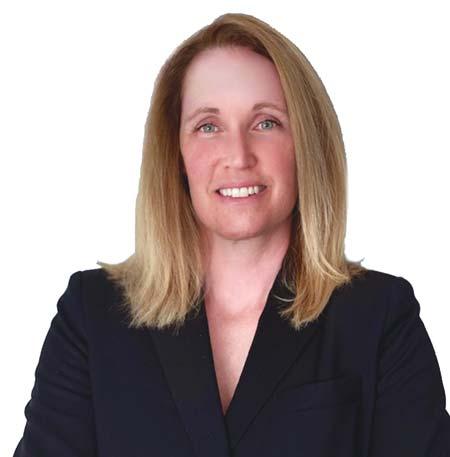
Are you responsible for digital transformation in your organization and desire an expert who can help you be successful? Are you organizing an event and need a provocative keynote to convey a call to action?
Elewana Advisory turns bold ambition into vision and execution. We specialize in helping organizations, like yours, navigate uncertainty and emerge stronger. Our services are built to future-proof your business, creating AI-driven strategies and compelling roadmaps enabling digital transformation. Incidentally, no AI was used in the creation of this content.
AI, innovation, and the future of nursing: A call for leadership
BY DR. THERESA MCDONNELL
cross North America, healthcare leaders face a defining moment. Staffing shortages, rising patient complexity, and operational inefficiencies are testing the limits of our nursing workforce. And yet, the biggest challenge isn’t just the numbers, it’s the burden placed on frontline nurses.
Nurses enter this profession to improve the health of those under our care yet many find themselves consumed by administrative tasks and diverted from the valuable work that only nurses can deliver to patients. Innovation must empower nurses,
not overwhelm them. That means deploying technology-driven workforce strategies, fostering nurse-led innovation, and strengthening global collaboration to redefine what excellence in nursing truly means. At Duke University Health System, we are building this change.
AI won’t replace nurses, but it will give them back time. Too often, discussions about AI in healthcare focus narrowly on clinical decision-making while overlooking the operational backbone of the profession –staffing, workflow efficiency, and documentation burdens.
At Duke, we are implementing AIdriven scheduling systems that dy-
namically adjust staffing levels based on real-time patient demand, with the potential of reducing overtime hours by 23 percent, improving retention rates by 18 percent, and decreasing documentation time per shift by 40 percent.
advanced patient monitoring systems are enhancing safety.

AI-enabled virtual assis-
tants are handling administrative tasks, predictive analytics are helping reduce avoidable hospital stays, and
Technology, when designed in collaboration with nurses, has the power to transform the profession by allowing nurses to spend more time where they are needed most: with patients. Yet technology alone will not solve systemic inefficiencies. The solutions must come from those who know patient care best, nurses themselves. That is why Duke launched the Nurse Innovation Summit, a structured initiative that empowers nurses to identify challenges, develop solutions, and rapidly prototype ideas with support from
Dr. Theresa McDonnell
Jennifer MacGregor is Managing Director and Founder, Elewana Advisory. She can be reached at: ElewanaAdvisory.com.
Trends in women’s health tech for 2025: A new frontier for innovation
BY LORI CASSELMAN
The women’s health technology sector, or femtech, is entering a transformative era, driven by innovation, unmet needs, and a growing recognition of the unique healthcare challenges faced by women.
Big tech companies, insurers, and other major global stakeholders are increasingly turning their attention to this space, driven by both the potential for impact and the need for specialized expertise.
To accelerate time-to-value and ensure impactful solutions, these organizations recognize the necessity of engaging expert leadership with deep domain knowledge. Several key trends highlight why this space is becoming an exciting new frontier for technological advancement.
Holistic and preventative care models: Women’s health is no longer limited to episodic care. Instead, there’s a growing focus on holistic health and wellness, encompassing physical, mental, and emotional well-being. Startups are creating platforms that integrate telemedicine,

lifestyle coaching, and mental health support – addressing the multifaceted needs of women at different life stages.
These comprehensive models not only enhance care but also optimize time-tovalue by reducing healthcare costs and improving outcomes.
Workplace support programs: The intersection of workplace wellness and women’s health is an emerging trend that Canadian companies are capitalizing on. Employers are increasingly recognizing the value of supporting employees through




The Rising femtech market: The global femtech market is projected to reach $50 billion this year, and Canada is well poised to be a significant contributor. Major health tech players are investing in solutions to address women’s health needs, recognizing the opportunity for rapid timeto-value in a market demanding swift innovation.
However, creating meaningful impact and generating positive returns in this space requires deep expertise, funding commitment and an informed understanding of women’s unique health challenges. The Canadian ecosystem, with its robust healthcare infrastructure and growing number of startups, is ripe for innovation in areas like reproductive health, menopause management and chronic disease prevention tailored to women.
Addressing mid-life health and menopause: Mid-life health, particularly menopause, is a largely underserved market with significant demand for innovative solutions. From wearable devices that monitor hormonal fluctuations to digital platforms offering personalized menopause coaching, to pharmaceuticals and supplements targeted to symptom management, new companies are stepping in to fill this gap.
These solutions aim to deliver personalized and more effective treatment options in a rapidly evolving market by addressing immediate needs, while laying the groundwork for long-term care models.
Personalized health tech powered by AI: Artificial intelligence and machine learning are revolutionizing how women’s health issues are diagnosed and managed. Canadian startups are leveraging AI to develop tools that offer real-time insights into hormonal changes, fertility tracking, and chronic condition management. These advancements align with the broader trend of precision medicine, emphasizing tailored care over one-size-fitsall solutions.
The speed at which AI-driven solutions can be deployed makes this an attractive focus for stakeholders looking to address gaps efficiently.




September 18 & 19, Toronto Congress Centre
Save Now With Early Bird Registration!
Why you should attend
• Stay ahead of the curve on AI, cybersecurity and EMR workflows
• Network with colleagues in the popular Vendor Showcase
• Discover how digital health supports Ontario Health Team priorities
• Solve issues at clinician-led EMR training workshops
• Earn continuing medical education credits
Open to all clinicians and practice staff. Group pricing is available for further discounts. Scan the QR code to learn more and register!
Sponsorship and Exhibitor Opportunities available. Email us at omd.events@ontariomd.com for more details.




Lori Casselman
Annual directory of leading healthcare information-technology suppliers
Accuro®EMR by QHR Technologies
200-1620 Dickson Avenue
Kelowna BC V1Y 9Y2
T: 1-855-550-5004
E-mail: info@accuroemr.com
Contact: Candus Hunter
Web: https://www.accuroemr.com
Accuro®EMR is a comprehensive electronic medical record platform that includes configurable clinic management tools to power clinics, and complete patient engagement tools that let users add secure virtual care to their clinic’s services. Accuro is the largest single-platform EMR in Canada.
Alcidion
c/o Fieldstone Law 4391 Harvester Road, Unit 5A Burlington ON L7L 4X1
E-mail: info@alcidion.com
Contact: Nick White Web: https://www.alcidion.com/ Alcidion is an Australian healthcare technology company that has a track record of providing leading software solutions to hospitals and healthcare providers. We offer a range of products and services that aim to improve the safety, efficiency, and quality of patient care. Alcidion’s software solutions include patient flow management and command centre systems, modular electronic medical record systems, patient administration systems, and advanced real-time data management and analytics solutions.
Amplify Care
235 The Boardwalk, Suite 301 Kitchener ON N2N 0B1
T: 519-885-0606
E-mail: info@amplifycare.com
Contact: Stephanie Dance Web: https://www.amplifycare.com/
Amplify Care is a Canadian leader in digital health solutions, helping primary care teams work smarter and more efficiently. Our innovative tools streamline workflows, reduce administrative burden, and improve patient care. We empower clinicians to focus on patients, not paperwork. Driving a more connected, responsive, and sustainable healthcare system.
AQuity Canada ULC/IKS Health
7501 Keele Street, Suite 305 Concord ON L4K 1Y2
T: 416-816-1196

Bialogics Analytics Inc.
16 Industrial Parkway S Aurora ON L4G 0R4
T: 416-580-2659
E-mail: info@bialogics.com
Contact: Jeff Vachon Web: www.bialogics.com
Bialogics Analytics Inc. is a leading health informatics company specializing in transforming radiology operations through real-time, data-informed decision support. By bringing transparency and trust to AI deployment, Bialogics empowers healthcare providers to achieve clinical excellence through evidence-driven insights across radiology.
AGFA HealthCare
375 Hagey Blvd
Waterloo ON N2L 6R5
T: 519-746-2900
E-mail: jacky.polesello@agfa.com
Contact: Jacky Polesello
Web: https://agfahealthcare.com
AGFA HealthCare is redefining diagnostic imaging with a connected, intelligent, and adaptive ecosystem that puts clinical excellence and user experience at the center supporting how clinicians work today and scaling for tomorrow. Our Enterprise Imaging platform combines cloud-native architecture, AI-powered workflows, and blazing-fast streaming to deliver seamless access and precision across radiology, cardiology, mammography, POCUS, and more. Built for clinical and IT harmony, AGFA Enterprise Imaging fits naturally into your workflow, keeping users focused, efficient, and confident – no matter where or how they work. From intelligent worklist orchestration to intuitive reporting, everything just works – so clinicians can focus on what matters most: delivering excellent care. That’s Life in Flow.

AIMS Powered by Lumenix 15 Akron Road
Etobicoke ON M8W 1T3
T: 1-855-586-3649
E-mail: info@aimsplatform.io
Contact: Michael Brunet
Web: https://www.aimsplatform.io
Lumenix is a leading provider of hardware, software, sensors, and artificial intelligence, serving thousands of clients across North America. The Artificially Intelligent Monitoring System (AIMS), powered by Lumenix, utilizes ambient intelligence and perceptual-action AI to monitor healthcare environments in real-time. With 3D sensors and predictive analytics, it provides anonymous, actionable insights that help prevent incidents, improve patient safety, and support clinical teams, while fully preserving privacy and workflow integration.

Amazon Web Services Canada (AWS) 120 Bremner Blvd Toronto ON M5J 0A8
T: 1-416-309-5300
E-mail: marcdub@amazon.com
Contact: Marc-André Dubois Web: https://aws.amazon.com/health/ AWS is the trusted technology and innovation partner to the global healthcare and life sciences industry, providing unmatched reliability, security, and data privacy. AWS for Health provides an offering of AWS services and AWS Partner solutions, used by thousands of customers globally.
E-mail: carey.silverstein@ikshealth.com
Contact: Carey Silverstein Web: https://ikshealth.com
Reducing physician burnout with intuitive documentation and workflow solutions.
Auxita
65 Denzil Doyle Court, Suite 201 Ottawa ON K2M 2G8
T: 613-864-3470
E-mail: julie.tremblay@auxita.com
Contact: Julie Tremblay Roy Web: https://www.auxita.com
Auxita’s digital platform seamlessly and securely connects physicians, patients, insurance providers, and patient support programs together – reducing administrative burdens and empowering medical practices to deliver care faster and more efficiently to patients.
Brightsquid Secure Communications Corp.
3655 36 Street NW Calgary AB T2L 1Y8
T: 800-238-6503
E-mail: jeff.mackay@brightsquid.com
Contact: Jeff MacKay Web: https://brightsquid.com/ Brightsquid provides secure digital communication tools and privacy compliance support services that safely create healthcare system efficiency and improve coordination across the circle of care to advance patient outcomes. Over 14,000 Canadian healthcare organizations use Brightsquid Secure-Mail to securely accelerate patient data exchange for better integrated team-based care.
Canon Medical Systems
Canada Limited
75 Tiverton Court

Markham ON L3R 4M8
T: 905-470-3538
E-mail: sherry.lyons@medical.canon
Contact: Sherry Lyons Web: https://ca.medical.canon/
For more than 100 years, Canon Medical has been at the cutting edge of diagnostic imaging, creating healthcare solutions that can help enrich life for everyone. Our full range of diagnostic medical imaging solutions – CT, PET-CT, MR, X-Ray, Angiography, Ultrasound, and Healthcare Informatics – coupled with deep learning technologies deliver uncompromised quality, insight, and value across the entire global care pathway.
Carestream Health Canada Company
290 Caldari Road, M1-20 Vaughan ON L4K 4J4
T: 1-866-792-5011
E-mail: infocanada@carestream.com
Contact: Jonathan Neville
From Imaging Centers to community hospitals to large academic providers, we offer flexible imaging solutions that can be
tailored to your facility’s needs and budget. Accelerate and evolve your digital transition with wireless DR solutions; both in-room and mobile, advanced imaging software and more – all designed to improve workflow, staff productivity and the quality of patient care, while reducing your costs.
CDW Canada
185 The West Mall, 17th Floor Toronto ON M9C 5L5
T: 647-965-9626
E-mail: jaime.lowry@cdw.ca
Contact: Jaime Lowry
Web: https://www.cdw.ca/ CDW Canada Corp. is a leading provider of technology services and solutions for business, government, education and healthcare. CDW Canada is the country’s trusted advisor for cybersecurity, hybrid infrastructure and digital transformation. CDW Canada experts design, orchestrate and manage customized services and solutions, making technology work so people can do great things.


Christie Innomed
516 Rue Dufour
Saint-Eustache QC J7R 0C3
T: 514-265-5631
Email: mharaoui@christieinnomed.com
Contact: Muriel Haraoui
Web: https://www.christieinnomed.com/
Christie Innomed is a leader in Medical Imaging Equipment, Health IT Solutions, Service Solutions & MVS with over 200 dedicated specialists across North America. Founded in 1954, we are committed to provide innovative medical technologies and leading-edge service solutions to maximize efficiency while improving the quality of patient care pathway.
Cloud DX
72 Victoria Street S, Suite 100 Kitchener ON N2G 4Y9
T: 888-543-0944
E-mail: sales@clouddx.com
Contact: Cara MacDonald
Web: https://www.clouddx.com/#/ Canada’s leading provider of Remote Patient Monitoring (RPM) solutions, trusted by 40+ Provincial Health Authorities (AB, BC, YK, PEI), Hospital Systems and Community Paramedic Services coast-to-coast. Available via Mohawk Medbuy. Integrated to the main EMRs in Canada. Offering >90% compliance and >90% user satisfaction in published surveys.
DeliverHealth
1741 Lower Water Street, Suite 600 Halifax NS B3J 0J2
T: 416-409-7163
E-mail: tracey.sharma@deliverhealth.com
Contact: Tracey Sharma
Web: https://ai.deliverhealth.com/
DeliverHealth is a digital health company that provides software, AI, and support services focused on clinical documentation. Our goal is to reduce the documentation burden on clinicians, lower costs through AI solutions, and integrate digital health solutions for patients. We simplify complex healthcare data, improve clinical workflows, and enhance both patient and provider experiences through technology and AIdriven solutions. We have over 800 health systems and 60,000 providers, that harnesses the power of A.I. to simplify complex medical data and improve patient care outcomes.
Densitas
66, 1344 Summer Street, Suite 311B
Halifax NS B3H 0A8
T: 902-405-4610
E-mail: media@densitashealth.com
Contact: John Leyva
Web: https://densitashealth.com
Its intelliMammo and intelliRisk platforms automate breast density classification, evaluate mammography positioning quality, and assess breast cancer risk, enabling radiology teams to improve mammography quality and high-risk patient tracking while meeting regulatory standards.
Enlitic
2510 East Harmony Road, Suite 202
Fort Collins CO 80528 USA
T: 216-681-3135
E-mail: dwilson@enlitic.com
Contact: Dave Wilson
Web: https://enlitic.com
We empower healthcare systems to enhance the quality of their imaging data leveraging artificial intelligence. Enlitic’s intelligent data framework powers critical workflows, orchestrates data and enables radiology data migration. Look at how much data is stored in your archive and ask yourself, “Can I turn that cost into a benefit?”
Epic
1979 Milky Way
Verona WI 53593 USA
T: 1-608-271-9000
E-mail: info@epic.com
Contact: Mercedes McCoy
Web: https://www.epic.com/ Epic develops software that helps people get well, helps people stay well, and helps future generations be healthier. Epic supports healthcare organizations in 16 countries, with more than 3,300 hospitals and 71,000 clinics using Epic and over 190 million patients using Epic’s MyChart patient portal to manage their care.
Ergotron
1181 Trapp Road
Eagan MN 55121 USA
T: 1-800-888-8458
E-mail: sales@ergotron.com
Contact: Sarah Bullock
Web: https://www.ergotron.com/en-ca/ Ergotron uses human-centered design principles and the Technology of Movement to build healthcare environments that help caregivers and patients thrive. Our ergonomic product innovations connect healthcare workers to technology in ways that improve human performance, promote human health, and enhance human happiness in the most challenging work conditions.
Fresenius Kabi
165 Galaxy Blvd, Unit 100 Toronto ON M9W 0C8
T: 1-877-779-7760 F: 1-844-513-1522
GoAutomate Inc.
Unit 14-75 Horner Avenue
Etobicoke ON M8Z 4X5
T: 416-479-0800
E-mail: hello@goautomatemd.com
Contact: Samantha Williams
Web: https://goautomatemd.com/ GoAutomateMD seamlessly integrates with health systems, enhancing workflows and interoperability without added complexity. Simplify referrals, enable smart booking, and streamline tasks with AI-powered protocoling and intelligent centralized waitlist management. Enjoy customizable worklist servers, DICOM anonymization, and more. Focus on patient care, let GoAutomate handle the tedious tasks for a more efficient healthcare environment.
CloudWave
100 Crowley Drive
Marlborough MA 01752 USA
T: 877-991-1991
E-mail: customersfirst@gocloudwave.com
Web: https://gocloudwave.com/
CloudWave is a full-service cybersecurity and cloud services provider exclusively for healthcare. Protecting over 300 hospitals and health systems, CloudWave delivers end-to-end solutions combining secure hosting, IT operations, and 24/7 threat detection. Services include managed security, risk and compliance, disaster recovery, and cloud optimization – all with a healthcarefirst approach. Powered by AI-driven security operations and supported by U.S.-based Network and Cybersecurity Tactical Operations Centers, CloudWave provides healthcare organizations with a cyber-ready foundation for safe, uninterrupted patient care.
Eaton
380 Carlingview Drive
Toronto ON M9W 5X9
T: 416-798-0112
Contact: Brenda Low
Eaton provides best in class equipment for medical grade power backup, charging, & connectivity. Our Safe-IT products help you save time, save money and reduce risk so your staff can focus on providing quality care to patients, not on supporting your tech.

ELLKAY
200 Riverfront Blvd Elmwood Park NJ 07407 USA
T: 520-481-2862
E-mail: Auna.Emery@ELLKAY.com
Contact: Julia Heres
Web: http://www.ELLKAY.com
ELLKAY is a trusted enterprise data management partner, driving innovation and connectivity across the healthcare ecosystem. Since 2002, ELLKAY has empowered hospitals, laboratories, payers, healthcare IT vendors, and more with unmatched data management expertise. With connections to over 58,000 practices and interoperability with 750+ EHR/PM systems across 1,100+ versions, ELLKAY delivers solutions that streamline data exchange, fuel value-based care, and drive smarter decision making. Discover more at ELLKAY.com and connect with us on YouTube, LinkedIn, X/Twitter, or via TeamELLKAY@ELLKAY.com.
E-mail: lucy.chen@fresenius-kabi.com
Contact: Lucy Chen
Web: https://www.fresenius-kabi.ca
Fresenius Kabi is a leading global healthcare company specializing in lifesaving medicines and technologies for infusion, transfusion, and parenteral nutrition. Our products and services help care for critically and chronically ill patients across Canada. We offer a range of innovative infusion therapy solutions for healthcare organizations.
GoldCare
445 Wes Graham Way, 104 Waterloo ON N2V 1K4
T: 1-800-463-2688
E-mail: melissa.tunks@mygoldcare.com
Contact: Melissa Tunks
Web: https://www.mygoldcare.com/ Cloud-based Healthcare & Information Management Software for Home Health Care, Children’s Services and Long-Term Care Organizations. GoldCare is the only software provider that offers a complete, end-to-end solution, from client, staff and clinical management to reporting, mobile options, and back-office financials with payroll.
Harmony Healthcare IT
3454 Douglas Road, Suite 300 South Bend IN 46635 USA
T: 800-781-1044
E-mail: info@harmonyhit.com
Contact: Colleen Dalton
Web: https://www.harmonyhit.com/ Harmony Healthcare IT is a data management firm that moves, stores, and manages patient, employee, and business records for healthcare organizations.
GE HealthCare 1919 Minnesota Court Mississauga ON L5N 0C9
T: 416-948-6608
E-mail: anukapoor@gehealthcare.com
Contact: Anu Kapoor
Web: https://www.gehealthcare.ca/
GE HealthCare is a leading global medical technology, pharmaceutical diagnostics, and digital solutions innovator, dedicated to providing integrated solutions, services, and data analytics to make hospitals more efficient, clinicians more effective, therapies more precise, and patients healthier and happier. Serving patients and providers for more than 125 years, GE HealthCare is advancing personalized, connected, and compassionate care, while simplifying the patient’s journey across the care pathway. Together our Imaging, Ultrasound, Patient Care Solutions, and Pharmaceutical Diagnostics businesses help improve patient care from diagnosis, to therapy, to monitoring.
Harris Healthcare
1 Antares Drive, Suite 400 Ottawa ON K2E 1C4
T: 647-286-6888
E-mail: elavoie@harriscomputer.com
Contact: Eric Lavoie
Web: https://www.harrishealthcare.com/ Harris Healthcare is at the forefront of delivering innovative and sustainable solutions tailored for the dynamic landscape of today’s healthcare, enhancing patient care and safety. Our commitment to innovation is exemplified by our latest offerings, Harris Arc and Harris Patient Timeline which are both designed and built in Canada by clinicians for clinicians to revolutionize patient care:
• Arc: the leading edge EHR, developed with a leading clinical partner in Canada, incorporates the latest technology including AI, FHIR and Cloud which will revolutionise hospital workflows, clinician satisfaction, and significantly enhance patient care.
• Patient Timeline: a smart clinical archiving solution which is an intuitive solution that manages your existing and legacy data and integrates seamlessly to any EHR offering unparalleled clinical decision support.

HealthHub Solutions
2000 Argentia Road, Plaza 5, Unit 400 Mississauga ON L5N 1W1
T: 1-365-656-2360
E-mail: contactus@healthhubsolutions.ca
Contact: Andrea Gianello
Web: https://healthhubsolutions.ca/
For over 55 years, HealthHub Solutions has partnered with Canadian patients, hospitals, and health systems to create an innovative portfolio of engagement solutions that provide a humancentered, effortless, and integrated experience for both patients and clinicians. HealthHub tackles the biggest issues in healthcare by identifying and aggregating applications at the point of care, to optimize patient and staff experience, health outcomes and operational efficiencies. HealthHub enables digital transformation for our partners in healthcare - and this starts at the bedside.
Healthquest
4246 97 Street NW, Suite 201
Edmonton AB T6E 5Z9
T: 866-438-3762 F: 780-434-6018
E-mail: brandon@microquest.ca
Contact: Brandon Blanck
Web: https://www.healthquest.ca
Microquest Inc. is the provider of Healthquest, Alberta’s premier EMR, and the freely available dr2dr Secure Messaging system. Founded in 1993, Microquest has been delivering effective healthcare solutions for over 30 years. Healthquest provides a full suite of tools, including electronic charting, claim entry, appointment scheduling, online booking, automated appointment reminders, customizable patient fillable forms, and a complete set of virtual care tools.
HPE Aruba Networking
1875 Buckhorn Gate, Suite 202 Mississauga ON L4W 5P1
T: 1-844-432-0485
Web: https://www.hpe.com/us/en/home.html
HPE is the global edge-to-cloud company built to transform your business by helping you connect, protect, analyze, and act on all your data and applications wherever they live, from edge to cloud.
Hypercare
108 College Street, Suite W680 Toronto ON M5G 0C6
T: 1-877-379-3533
Contact: Albert Tai
Web: https://www.hypercare.com/ Hypercare is a secure, cloud-based platform designed to streamline clinical communication and coordination in real time. Trusted by hospitals and healthcare systems across North America, Hypercare helps teams eliminate communication delays, improve response times for critical events and streamline clinical workflows.
IDENTOS Inc.
317 Adelaide Street W, Suite 901
Toronto ON M5V 1P9
T: 833-964-7572
Contact: Joe Mayer
Web: https://www.identos.com/ IDENTOS makes digital access and consent management easy and secure for patients and ALL members of their care team. Its privacyrespecting digital identity, authorization and consent services, power IDENTOS to extend interoperability, enable patient-mediated workflows and empower granular data governance within and between organizations and jurisdictions. Founded in 2014 and headquartered in Toronto, IDENTOS is trusted by North American governments and healthcare providers to power their digital infrastructure and last-mile digital solution at scale.
InBodyCanada
4338 Innes Road, Suite 75
Ottawa ON K4A 3W3
T: 613-297-3777
E-mail: info@inbodycanada.ca
Contact: Eric Lavoie
Web: https://inbodycanada.ca/
InBody is an innovation-focused company with the goal of creating a better world for today and future generations to come. Our medical-grade devices are used by professionals in the medical, fitness, research, and corporate wellness verticals.
KA Imaging
3-560 Parkside Drive Waterloo ON N2L 5Z4
T: 226-215-9897
E-mail: sales@kaimaging.com
Contact: Charlie Hicks
Web: https://www.kaimaging.com
KA Imaging develops advanced medical X-ray imaging solutions, including the patented SpectralDR technology. Their portable solutions enable dual-energy imaging with a single exposure, improving diagnostic accuracy and patient outcomes. Designed for versatility, accessibility, and efficiency, KA Imaging’s systems enhance care in hospitals, clinics, and resourcelimited or remote healthcare settings.
INFINITT North America
755 Memorial Parkway, Suite 304 Phillipsburg NJ 08865 USA
T: 908-346-6181
E-mail: info@infinittna.com
Contact: Jay Marteniuk
Web: https://www.infinittna.com/
INFINITT North America is a global enterprise imaging partner for medical institutions. We’re a wholly-owned subsidiary of INFINITT Healthcare, a global healthcare information technology company with world-class research and development capabilities and robust subspecialty and multi-facility solutions.
Interlace Health
13421 Manchester Road, Suite 208
St. Louis MO 63131 USA
T: 314-607-7202
E-mail: lziegler@interlacehealth.com
Contact: Lauren Ziegler
Web: https://interlacehealth.com/
For more than 30 years, Interlace Health has pioneered EHR-integrated eForms, eSignature, and workflow technology. Interlace Health’s platform enables several solutions that are accessible by clinicians and patients inside and outside the walls of the healthcare system. These include Forms on Demand, Patient Intake, and Informed Consent.
Kwickscreen/KwickSwitch
150 Duncan Mills Road, Unit 2 North York ON M3B 3M4
T: 416-428-1710
E-mail: johnt@kwickscreen.ca
Contact: John Turnbull
Web: https://www.kwickscreen.com
Discover KwickScreen’s mobile medical privacy screens, switchable glass film and infection control solutions. Easy-to-clean, privacy systems for hospitals, clinics, and healthcare facilities.

Lanier Healthcare Canada
980 Adelaide Street S, Unit 36 London ON N6E 1R3
T: 519-649-4880
E-mail: Cwelbourn@lhcc.ca
Contact: Chris Welbourn
Web: https://www.lhcc.ca/
Lanier Healthcare Canada provides cutting-edge AI Assisted Speech Recognition technologies that are transforming reporting. These solutions enable healthcare professionals to swiftly generate precise patient documents directly into any application, from anywhere, across multiple systems. Lanier specializes in workflow automation to distribute critical results, automate worklists, and crucially facilitate quality assurance.
MDClone
360 S. Kiely Blvd, Suite 250 San Jose CA 95129 USA
T: 814-704-7656
E-mail: communications@mdclone.com
Contact: Andrew Matthews
Web: https://www.mdclone.ca
MDClone transforms healthcare data into actionable insights through advanced analytics and synthetic data technology. Supporting health systems, researchers, and governments, MDClone enables secure data access and sharing – powering national networks, accelerating innovation, and driving measurable improvements in care, research, and policy across the healthcare ecosystem.
MedCurrent, A VitalHub Company
480 University Avenue, Suite 1001
Toronto ON M5G 1V2
T: 1-855-279-3380
E-mail: Martin.Kepa@vitalhub.com
Contact: Martin Kepa
Web: https://www.medcurrent.com/
MedCurrent is a physician-founded Clinical Decision Support (CDS) company focused on improving the quality of care and managing health system costs through our innovative and scalable solution, OrderWise. Our solution enhances the clinical decision-making process with real-time, evidence-based guidelines integrated at the point of care to improve health and healthcare delivery.
MEDITECH
7 Blue Hill River Road Canton MA 02021 USA
T: 617-319-2890 F: 781-821-2199
E-mail: mmobasseri@meditech.com
Contact: Mitra Mobasseri Web: https://ehr.meditech.com
As Canada’s leading HIS solution provider for over four decades, MEDITECH software facilitates care in nearly every jurisdiction. We’re also the leading supplier of complex health authority and multi-site clustered environments. MEDITECH empowers healthcare organizations to expand their vision of what’s possible with Expanse, the intelligent EHR platform.
Merge by Merative
IQVIA
16720 Trans-Canada Highway, Suite 100 Kirkland QC H9H 5M3
T: 514-428-5000
E-mail: canadainfo@iqvia.com
Contact: Dheeman Vaidya
Web: http://www.iqvia.com/canada
IQVIA is a leading provider of clinical research services, commercial insights and healthcare intelligence to the life sciences and healthcare industries. Our portfolio of solutions is powered by IQVIA Connected Intelligence, delivering actionable insights and accelerating innovations. IQVIA MedTech supports the needs of the Medical Device and In Vitro Diagnostics industry.

Island Corporation
1 Keyes Court, Unit 1 Vaughan ON L4H 4V6
T: 905-695-9129
E-mail: sales@island.ca
Contact: Isabelle Drolet
Web: https://island.ca/
Island Corporation has 33 years of experience providing medical displays for radiology, pathology, and clinical applications. We are an IT services company with a focus on clinic support, healthcare security, risk mitigation, disaster recovery, and network infrastructure. Contact us for special pricing on Barco, Eizo and LG medical displays available to all radiologists across Canada.
LGI Healthcare Solutions
1500-1010 de la Gauchetiere W Montreal QC H3B 2N2
T: 1-800-261-9659
E-mail: info@lgisolutions.com
Contact: Lucky Bhatti
Web: https://lgisolutions.com/healthcare
LGI Healthcare Solutions delivers a comprehensive portfolio of software solutions that are at the heart of critical infrastructure of healthcare facilities, offering reliable support for essential daily operations. Deeply rooted in Canada for over 40 years, we also serve healthcare facilities internationally, including in the United States, Australia, the United Kingdom, and France.
Lumeca Health Inc.
2 Research Drive, Suite 150 Regina SK S4S 7H9
T: 1-844-658-6322
E-mail: sales@lumeca.com
Contact: Tom Douglass Web: https://lumeca.com/ Lumeca provides AI-enabled virtual care platforms that streamline care delivery through integrated AI patient intake, autoscribe technology, secure messaging, and video consultations. Trusted by over 4,000 clinicians in Canada.
2680 Skymark Avenue, Suite 200 Mississauga ON L4W 5L6
T: 1-844-637-2848
Contact: Andrew Longoria Web: https://www.merative.com/merge-imaging
Merge by Merative delivers advanced medical imaging solutions to enhance workflows, optimize care delivery, and improve patient outcomes. Built on a cloud-native foundation, solutions include Vendor-Neutral Archive (VNA), PACS, Workflow Orchestration, Cardiology and hemodynamics, and digital pathology.
meshMD Inc.
91 Tycos Drive, Unit 204 Toronto ON M6B 1W3
T: 888-440-1509
E-mail: info@meshmd.com
Contact: Merv Dsouza Web: https://meshmd.com
meshMD offers a SaaS platform for the life science industry. We power a virtual Patient Support Program, Adverse Events reporting, Free Goods Management, and Nursing Time and Attendance Management.
Microsoft
One Microsoft Way Redmond WA 98052 USA
T: 781-565-5000
E-mail: benjaminhebb@microsoft.com
Contact: Benjamin Hebb Web: Radiology Solutions | Microsoft Cloud for Healthcare Advance radiology with Microsoft for Healthcare, empowering teams to streamline report creation, surface key insights, and automate workflow with
unmatched security and scalability. Enhance efficiency through AI-driven workflow, actionable insights, and a trusted partner ecosystem. An award-winning network connects imaging stakeholders, facilitates seamless image exchange, and provides unified access to a curated collection of third-party AI models.
Northwest Telepharmacy Solutions
2 Alexander Place, Box 606
Deep River ON K0J 1P0
T: 1-888-933-3065 ext. 102
E-mail: info@northwesttelepharmacy.ca
Contact: Sammu Dhaliwall
Web: https://www.northwesttelepharmacy.ca/
NTS provides professional pharmacist and pharmacy technician services to Hospitals and health institutions across Canada. Recent launches include Medication Reconciliation, sterile compounding delegation, and Virtual Reality training modules.
Nova Networks Inc.
255 Smyth Road
Ottawa ON K1H 8M7
T: 613-282-1468
E-mail: TRoffey@novanetworks.com
Contact: Tyson Roffey
Web: https://www.NovaNetworks.com
Your HIMSS Certified Technology Partner –Security Solutions – Managed Services –Professional Services – Digital Solutions –Technical Services – Consulting – End-User Device Management.
Novari Health
1473 John Counter Blvd
Kingston ON K7M 8Z6
T: 613-531-3008
E-mail: sales@novarihealth.com
Contact: David Mosher
Web: http://www.novarihealth.com
Novari Health works with hospitals, regional health authorities and provinces to improve referral workflows, enable central intake models and reduce wait times with better wait list management. Our cloud-based software solutions integrate with HIS (e.g., Oracle, Meditech, etc.), PACS and other systems. Headquartered in Canada, with offices in Australia, New Zealand, and the United Kingdom, Novari is one of the largest and fasted growing Canadian based digital health solution providers.
Nuon Imaging Inc.
A18A-6120 2 Street SE Calgary AB T2H 2L8
T: 866-455-3050
E-mail: info@nuonimaging.ca
Contact: Mark Little
Web: https://nuonimaging.ca/human-home/ Nuon Systems (a division of Nuon Imaging) provides customized diagnostic imaging IT solutions to meet the needs of Imaging clinics across Canada. We supply Digital Radiography & IT Hardware/Software from the industry’s most trusted manufacturers. In addition, we offer maintenance plans, general service & support to ensure your equipment is well-maintained, secure, and working perfectly for many years to come.
Pentavere Research Group Inc.
460 College Street Unit 301 Toronto ON M6G 1A1
T: 647-702-8820
E-mail: info@pentavere.com
Contact: Aviva Pratzer
Web: https://pentavere.ai/
Pentavere, a HealWELL AI company, is a globally recognized digital healthcare company revolutionizing clinical insight discovery with its proprietary AI engine, DARWEN. Designed with trust and privacy at its core, DARWEN rapidly analyzes unstructured clinical text to uncover life-saving insights, helping close care gaps and improve patient outcomes. DARWEN delivers unmatched accuracy, speed, and costefficiency, earning trust from leading institutions and recognition in top peerreviewed journal.
Pixalere Healthcare Inc.
The Future of Wound Care
T: 866-297-2442
E-mail: info@pixalere.com
Contact: Ken Hendsbee
Web: http://www.pixalere.com
Increased access. Decreased administrative burden.
Pure Storage
2555 Augustine Drive
Santa Clara CA 95054 USA
T: 800-379-7873
E-mail: info@purestorage.com / bbryer@purestorage.com
Contact: Bill Bryer
Web: https://www.purestorage.com/
Petal
150 King Street W Suite 306-02
Toronto ON M5H 1J9
T: 888-949-8601
E-mail: vbrasseur@petal-health.com
Contact: Valerie Brasseur
Web: https://www.petal-health.com/
Petal, a leading Canadian health technology solutions and consulting company, enhances healthcare by improving care delivery across the continuum. Through real-time orchestration, capacity management and enabling data-driven forecasting, Petal empowers organizations to build agile, efficient, and humane healthcare systems.
PFU Canada Inc., a RICOH company
2865 Bristol Circle Suite 200
Oakville ON L6H 6X5
T: 416-254-3156
E-mail: soblin@pfu-ca.ricoh.com
Contact: Steve Oblin Ricoh document scanners.
PHILIPS Canada Ltd.
1875 Buckhorn Gate 5th Floor
Mississauga ON L4W 5P1
T: 484-643-8847
E-mail: giridhar.poondi@philips.com
Contact: Nathan Bluvol Web: https://www.philips.ca/healthcare/solutions/ clinical-informatics/radiology-informatics
The top healthcare innovators rely on Pure Storage to redefine the storage experience and simplify how people consume and interact with data. Pure’s fast and future-ready storage transforms data into value across the entire healthcare enterprise. Pure powers the EHRs, enterprise imaging, back-office systems and more with storage that delivers 99.9999% uptime and robust data protection.
Purestorage.com/healthcare
Orion Health
120 Adelaide Street W, Suite 1010
Toronto ON M5H 1T1
T: 647-535-3853
E-mail: kara.hill@orionhealth.com
Contact: Jasmine Barber
Web: https://orionhealth.com/ca/
Orion Health, a HEALWELL AI company, is transforming global healthcare through AI-driven insights, smarter decision making, and more intelligent care coordination. Orion Health’s Unified Healthcare Platform is underpinned by extensive health and social data sets, machine learning, and over 30 years of innovation focused purely on improving global wellbeing.
Philips is a leading-edge supplier of clinical informatics and radiology informatics solutions, including the following: Philips Clinical Repository (Vendor Neutral Archive); Philips Enterprise Viewer (Medical Image Sharing); Interactive Multimedia reporting (Radiology Image Management PACS); Radiology Operations Command Center (ROCC); Performance Bridge; Patient Portal (Patient Engagement Platform); Philips Digital Pathology; Advanced Visualization Workspace Platform; Cardiovascular Workspace (IntelliSpace Cardiovascular or ISCV); Philips Hemo with IntelliVue X3; Interventional Cardiology Workspace (Xper IM); Ultrasound Workspace (TOMTEC); Philips Medical Device Integration; Philips Capsule Surveillance; Philips Clinical Insights Manager; and Inpatient Telehealth - Philips eCareManager.
Purkinje
740 rue Notre-Dame Ouest Suite 1575
Montréal QC H3C 3X6
T: 514-355-0888
F: 514-355-0481
E-mail: mtine@purkinje.com
Contact: Marius Tine
Web: https://purkinje.com
Purkinje est une société spécialisée dans le développement et l’intégration de logiciels dans le secteur de la santé. Son domaine de spécialisation est principalement celui des dossiers médicaux et des services professionnels en intégration de systèmes en santé.
Purkinje is a company specializing in software development and integration in the healthcare sector. It specializes mainly in health records and professional services in healthcare systems integration.

QLogitek
5500 Explorer Drive, 3rd Floor Mississauga ON L4W 5C7
T: 705-840-6000
E-mail: info.esm@qlogitek.com
Contact: Marc Rancourt
Web: https://qlogitek.com/Services/EnterpriseService-Management/Marval-Solutions
QLogitek has been delivering ITSM and ESM solutions for Canadian healthcare institutions for over 20 years. As a supplier partner with Mohawk Medbuy, members can access our Marval ESM solution without the need to go to RFP. Marval is a proven solution that streamlines procurement and accelerates service transformation, with secure, scalable technology.
Quest Diagnostics
4690 Parkway Drive, Suite B Mason OH 45040 USA
T: 201-559-2905 F: 513-229-5517
E-mail: vicki.m.joyce@questdiagnostics.com
Contact: Vicki Joyce
Web: https://www.questdiagnostics.com/businesssolutions/hospitals-health-systems/enterprisecontent-management/contact-quanum-ecs-ad Quanum Enterprise Content Solutions is part of the Quest technology brand and is a document and content management solution which empowers hospitals, health systems, and large ambulatory groups to intelligently capture, manage, and deliver clinical and business content to the right systems, users, and workflows. www.QuanumECS.com

RealTime Medical
7111 Syntex Drive, 3rd Floor Mississauga ON L5N 8C3
T: 888-590-5069
E-mail: software@realtimemedical.com
Contact: Ian Maynard
Web: https://realtimemedical.com/
RealTime Medical (RTM) is a clinicianfounded, leading radiology software/service company at the forefront of diagnostic imaging workflow innovation. Through its AICloudSuite platform, RTM delivers advanced, AI-driven solutions that delivers optimal workflow orchestration, workload balancing and first-ofa-kind multidimensional peer learning to over 30 hospitals and clinics.
Riverain Technologies
3130 S. Tech Blvd
Miamisburg OH 45342 USA
T: 937-750-6744
E-mail: ClearRead@riveraintech.com
Contact: Mandy Bayman
Web: https://www.riveraintech.com/ ClearRead CT first suppresses vessels and machine noise for an unimpaired view of the chest. Then, pulmonary nodules are detected, segmented, and compared with corresponding nodules on the prior exam. Finally, CAC is quantified using the Agatston score. ClearRead CT findings, volumetrics, and scores are then included in the radiology report.
Sectra Canada Inc.
2000 Argentia Road Plaza 4, Suite 250 Mississauga ON L5N 1W1
T: 1-437-889-0600
E-mail: info.can@sectra.com
Contact: Nader Soltani
Web: https://medical.sectra.com/
With over 30 years of innovation and more than 2,000 installations around the globe, Sectra is a leading imaging IT provider to health systems worldwide. Sectra offers a complete enterprise solution comprised of imaging modules (radiology, cardiology, pathology, orthopedics, and ophthalmology) and a robust VNA. Sectra has been awarded “Best in KLAS” 2023 for high customer satisfaction for four consecutive years in Canada.
Siemens Healthineers
1577 North Service Road E Oakville ON L6H 0H6
T: 647-613-7777
E-mail: archana.nair@siemens-healthineers.com
Contact: Archana Nair
Web: https://www.siemens-healthineers.com/en-ca
Siemens Healthineers pioneers’ breakthroughs in healthcare. For everyone. Everywhere. Sustainably. As a leading medical technology company, Siemens Healthineers is committed to improving access to healthcare for underserved communities worldwide and is striving to overcome the most threatening diseases. The company is principally active in the areas of imaging, diagnostics, cancer care and minimally invasive therapies, augmented by digital technology and artificial intelligence.
Solventum
2510 Conway Avenue
St. Paul MN 55144 USA
T: 1-612-842-1263
Solventum is a new healthcare company built from a legacy of innovation and dedicated to enabling better, smarter, safer healthcare to improve lives. With more than 70 years of delivering healthcare innovations, we continue to move the industry forward by helping to solve our customers’ biggest challenges.
Strata Health, A VitalHub Company
1811 4 Street SW, Suite 924
Calgary AB T2S 1W2
T: 403-261-0616
E-mail: Kevin.Jones@vitalhub.com
Contact: Kevin Jones
Web: https://stratahealth.com/ca
Strata Health is an all-in-one Referral Management Solution for hospitals and health systems. Strata Health’s platform enhances the navigation of complex health systems for patients and providers.
Swift Medical
1 King Street W, Suite 4800–355
Toronto ON M5H 1A1
T: 888-755-2565
E-mail: info@swiftmedical.com
Contact: Neil Sharma
Web: https://swiftmedical.com
Swift Medical is the global leader in digital wound care focused on improving clinical and economic outcomes through our leading, AIpoweredplatform.
Terra Nova Transcription Inc.
100 Elizabeth Avenue, Suite 122
St. John’s NL A1B 1S1
T: 1-866-726-1367
E-mail: m.french@terranovanow.com
Contact: Maria French
Web: https://www.terranovanow.com
With Terra Nova’s team of transcriptionists, editors, and quality assurance specialists, you can focus on delivering high-quality patient care.

UKG Canada
155 Bloor Street W, Suite 400
Toronto ON M5S 1P7
T: 1-800-432-1729
Contact: Chris Krasinkiewicz
Web: https://www.ukg.ca
HCM solutions used to manage more than 485,000 Canadian health care workers. Modern, connected HR technology to actively and intelligently support you and your people. From smooth recruiting and seamless onboarding to clear and transparent benefits management, provide an easy path to help find, attract, and retain the right people. Stay ahead of day-to-day changes, foster a sense of belonging, and consistently maintain team performance and motivation. Automate scheduling, timekeeping, and leave management to facilitate coverage and regulatory compliance, optimize your time, and open the door to continuous improvement.

UpCare Partners & Associates Inc.
150 King Street W, Suite 306-04
Toronto ON M6G 3G6
T: 416-238-1111
E-mail: contact@upcarepartners.com
Contact: Sherry Blondin, Senior National Dir., Business Development
Web: https://upcarepartners.com/en/
We are a commercial partner of innovative medical technologies in neurosciences, specializing in value creation for Canadian healthcare. Upcare Partners and Associates Inc. drives innovation in neuroscience across Canada, collaborating with leading partners including Hyperfine, Brainlab, Avicenna, Olea Medical, FHC, NordicNeuroLab, Icometrix, Pearl Technology, and now iRegained.
Verto Health
325 Front Street W, Suite 400 Toronto ON M5V 2Y1
T: 833-936-0330
E-mail: sales@verto.ca
Contact: Michael Millar
Web: https://verto.health/
Verto Health, a leading Canadian scale-up, delivers Digital Twin journeys for Population Health with our patented AI technology.
VitalHub Corp.
480 University Avenue, Suite 1001
Toronto ON M5G 1V2
T: 1-855-699-0123
E-mail: Sales@vitalhub.com
Contact: Niels Tofting
Web: https://www.vitalhub.com
VitalHub is a leading software company that empowers Health and Human Services providers. Clients include hospitals, regional health authorities, mental health, and addictions services providers (Child through Adult), home health agencies, correctional services, and community and social services providers.
AI: Balancing oversight and innovation
governance standards that align with Canada’s Personal Information Protection and Electronic Documents Act (PIPEDA), and in the future the proposed Consumer Privacy and Protection Act (CPPA), also under bill C-27. Their focus includes transparency in AI-driven decision-making and patient consent for AI-based analytics.
•Industry & Research Institutions: Organizations like Canadian Institute for Advanced Research (CIFAR) and the Vector Institute are influencing AI policy discussions, advocating for responsible AI development in healthcare. Their research supports a pan-Canadian AI strategy that emphasize fairness, accountability, and bias reduction while positioning Canada as a world leader in AI innovation.
•Healthcare Institutions & Associations: Hospitals, medical associations, and patient advocacy groups contribute to AI policy debates, ensuring regulations align with real-world clinical needs. Their input is crucial in assessing whether AI solutions improve healthcare efficiency without compromising patient care or clinician workflows.
Preparing for what’s next: As AI continues to reshape healthcare, regulatory frameworks must keep pace to balance innovation with patient safety and ethical considerations. Canada’s evolving AI policy landscape mirrors global trends but remains uniquely influenced by its decentralized healthcare system. Moving forward, it will be critical for policymakers, healthcare organizations, and AI developers to work collaboratively to shape regulations and best practices that support safe, effective, and equitable AI adoption.
The question isn’t whether AI will revolutionize healthcare – it already has. The
real challenge is ensuring that regulation enables, rather than stifles, AI’s potential to improve patient outcomes and system-wide efficiencies. Staying engaged in the policy conversation will be key for all stakeholders invested in AI’s future in Canadian healthcare.
While waiting for federal and provincial AI legislation and guidance, healthcare organizations, with AI in mind, should:
•Review/update data strategies and governance frameworks
•Examine/update ethics and privacy policies
•Educate employees. Education about AI is important for healthcare executives
As AI reshapes healthcare, regulatory frameworks must keep pace to balance innovation with safety.
and staff to make effective decisions and use of AI tools, and to safeguard patient information and safety. The National Institutes of Health Informatics in partnership with McMaster University Continuing Education offers an introduction to AI focused on healthcare. This microcredential course aims to help participants understand the main types of AI, potential applications, implementation guidelines, and legal, regulatory and ethical considerations. For more information, see www.nihi.ca.
Laurie Lafleur MBA, CIIP, is Founder, ReImagine Health IT Consulting; Professor, Health Information Science, Conestoga College; Instructor, National Institutes of Health Informatics. Shirley Fenton, MA, is CoFounder, Waterloo MedTech and President, National Institutes of Health Informatics.
Workday
200 Wellington Street W, Suite 701 Toronto ON M5V 3C7
T: 1-877-967-5329
E-mail: ankit.deo@workday.com
Contact: Ankit Deo
Web: https://www.workday.com/enca/solutions/industries/healthcare.html
Workday is the AI platform that helps organizations manage their most important assets – their people and money. The Workday platform is built with AI at the core to help customers elevate people, supercharge work, and move their business forever forward. For more information about Workday, visit workday.com/en-ca
Trends in women’s
health tech for 2025
Zebra Technologies, Corp.
2100 Meadowvale Blvd
Mississauga ON L5N 7J9
T: 905-812-6400
Contact: Bas (Basim) Al-Ali
Web: http://www.zebra.com
Enable healthcare teams with more time and control by leveraging proven technology from Zebra. We offer the broadest portfolio of healthcare IT solutions, including rugged handheld computers, tablets, barcode scanners, printers, RFID readers, software, and more.
CONTINUED FROM PAGE 17
life transitions like family planning, postpartum support, menopause and caregiving.
Startups offering enterprise-grade solutions for workplace wellness programs have a dual advantage: improving employee retention and building scalable B2B models. These programs also demonstrate a clear, measurable return on investment for organizations seeking to foster healthier work environments.
Why Canada and why now? Canada’s healthcare innovation ecosystem is bolstered by government support, research institutions, and a diverse talent pool. Additionally, Canadian consumers and healthcare providers are increasingly open to adopting digital health solutions, creating a fertile ground for femtech innovation. These factors, combined with the global momentum in women’s health tech, position Canada as a potential leader in this space.
The road ahead: The women’s health tech sector offers a rare convergence of
social impact and technological advancement. With the rise of digital health solutions, personalized care, and AI-driven platforms, the potential for creating transformative innovations in women’s health has never been greater.
As the world embraces more inclusive approaches to healthcare, the technologies emerging from this space are likely to
Talented developers, government and academia are converging to position Canada as a femtech leader.
shape the future of care delivery, offering significant benefits to individuals and healthcare systems alike. For tech innovators and industry leaders, the focus on rapid time-to-value makes this an area of immense potential.
Lori Casselman is CEO of June Health, a company that is building accessible, connected support for midlife women.
How AI is helping enable a new generation of smart prosthetic limbs
inforcement-learning-enabled prosthetic limbs could do at Cybathlon 2024. This international competition is the premier showcase for the latest advancements in assistive technology, drawing in research teams from around the world to showcase how their work is making these devices suitable for everyday use.
The BLINC team placed 8th in the world in Cybathlon’s ARM competition with their AI-enabled “Bento Arm.” The 3D-printed artificial limb has five degrees of freedom (shoulder rotation, elbow flex, wrist rotation, wrist flex, and hand open/close) and was controlled using muscle movements by the team’s pilot, Chris Neilson.
Pilarski said the team’s success “was all about finding the right technology for the challenges at hand; our team blended machine learning control with conventional prosthesis control solutions, and also innovative physical solutions. Informed by our pilot Chris’s experience, and combined with his skill in using this competition-grade arm, it truly was a multidisciplinary success story.”
While events like Cybathlon are more
Digital navigators
CONTINUED FROM PAGE 6
for the use of digital health technologies, research is still needed to not only build greater awareness around the utility of this role but also understand its feasibility and how it may be sustained and scaled in Canadian contexts.
Given this gap in knowledge, a team at the Centre for Addiction and Mental Health in Toronto, Ontario, has received funding from the Canadian Institutes for Health Research to conduct a national study exploring the feasibility of the digital navigator role.
The project, led by Dr. Gillian Strudwick and Dr. Sean Kidd, will involve a comprehensive review of existing research and in-depth interviews with clinicians, patients, and healthcare administrators across the country. Ultimately the project aims to uncover the practical applications of this role, the primary responsibilities as-
A call for leadership
CONTINUED FROM PAGE 16
engineering and business experts.
This initiative has produced incredible results, such as a Virtual Reality (VR) Training Platform for Workplace Violence Response, which has already facilitated over 5,000 training hours and led to a reduction in workplace aggression incidents.
The implementation of Smart IV Pump Standardization has reduced medicationrelated errors by 19 percent, and AI-enhanced discharge planning has resulted in a measurable decrease in hospital stays.
These innovations reinforce a fundamental shift that nurses are more than caregivers – they are problem solvers, innovators, and architects of the future.
As healthcare systems evolve, investments in nursing education must keep pace. The relocation of Watts College of
about showcasing advancements and sharing knowledge than it is about winning, Pilarski said competitions like it play a vital role in prosthetics research. It can be
The Alberta team placed 8th in the world in Cybathlon’s ARM competition with their AI enabled Bento Arm.
easy to fall into the trap of developing technology that is sophisticated and groundbreaking but might not be the best solution for the people using it.
Events like Cybathlon, where the events are focused on the kinds of skills and tasks that artificial limb users actually need to do in the real world, keep researchers focused on the people, not just the tech.
BLINC, in conjunction with the Glenrose Hospital Foundation, produced a short documentary on the journey to the competition and their success, which highlights the team’s heavy focus on collaboration.
The team’s performance at Cybathlon was the result of more than a decade of refining their Bento Arm design. From the
sociated with the role, sustainable funding models, and the barriers and facilitators to implementation in healthcare settings.
The findings from this work have the potential to offer valuable insights into future models of digital health technology.
As the Canadian digital health landscape continues to evolve, the way in which support is provided to make use of these digital technologies must as well. The digital navigator role represents a promising step towards more equitable and accessible care, where technology can serve as a bridge to better care rather than a barrier.
Iman Kassam, MHI, is Manager, Digital Innovation Hub, Centre for Addiction and Mental Health; Gillian Strudwick RN, PhD, is Scientific Director, Digital Innovation Hub, Chief Clinical Informatics Officer, and Senior Scientist, Centre for Addiction and Mental Health; Sean Kidd, PhD, is Psychology Division Chief, Senior Scientist, and Clinical Psychologist, Centre for Addiction and Mental Health.
Nursing (WCON) to the Duke University campus is a strategic step in strengthening the nursing workforce pipeline.
By integrating with Duke Health’s Interprofessional Education and Care Center, WCON students and faculty gain access to world-class resources while maintaining the college’s independent identity. This move enhances collaboration between WCON, Duke’s School of Nursing, and Duke Health’s clinical education teams, ensuring that nursing graduates are highly skilled and prepared to lead in patient care and healthcare innovation.
Canada’s healthcare system, built on publicly funded, patient-centered care, has an opportunity to lead in redefining nursing excellence on a global scale.
Duke is leading a global coalition of healthcare institutions in Canada, Singapore, and Europe to develop a data-driven, flexible framework that prioritizes workforce adaptability, seamless integra-
very start, the team has taken an opensource approach to their research, with the aim of sharing what they’ve discovered with others aiming to advance assistive technology. Both the hardware and software for the Bento are open-source and easily accessible on the lab’s website, to allow others to build on the team’s groundbreaking work.
“Making technology accessible is a top priority for our lab,” said Pilarski. “As a community, we can build novel solutions for and with users in ways we never could in isolation. BLINC designs have been built and deployed in hospitals, companies, and universities all across the globe.”
Designing the future of assistive technology: This past year, the researchers at BLINC lab secured a $1.5 million (US) grant to pursue bone-anchored, abovethe-elbow prosthetics with a unique “made in Edmonton” AI-enabled control system.
Bone-anchored prostheses represent a significant advancement over traditional prosthetics, which are typically attached to the body using straps, harnesses, or sockets. Instead, these devices are directly attached to the person’s skeleton. This direct attachment not only improves the stability and control of the prosthesis but also allows for a more intimate connection between the device and the user’s body.
In addition to this stability, Pilarski said the project will explore methods to more closely wire the prosthetics with the user’s existing nerves, allowing even more intuitive control of the device.
“It’s going to be really exciting because it allows us to leverage some of our local expertise in artificial intelligence to change the way the world thinks about how people use bone-anchored devices and other tightly coupled prosthetics.”
Testing smartwatches to predict heart-failure
of heart disease. He explained that HF patients are often in poor condition, and what is easy for a healthy person to do is often difficult for a patient with heart failure. “Even going up the stairs, dressing themselves, eating, can actually push them to exertion,” he said.
However, the goal is that by monitoring the patient over time, using the Apple Watch, researchers and clinicians will be
If the testing is successful, smart watches could be used to better monitor HF patients wherever they may live.
able to more readily detect whether the patient is deteriorating.
“We want to understand the relationship between this free-living environment and the progression of disease,” said Dr. McIntosh.
Also factored into the study is whether the patients have needed to go to hospital during the time of the study – which is also an indication of poor health.
tion of innovation and technology, and patient outcomes over rigid, outdated accreditation models. A modernized approach to nursing excellence will drive sustainability, improve patient safety,
Nurses are more than caregivers; they are problem solvers, innovators and architects of the future.
and enhance financial efficiency.
The need for change is no longer up for debate. What matters now is how decisively and effectively healthcare leaders act. AI must be integrated to optimize staffing, streamline workflows, and reduce burnout.
Nurse-led innovation must be prioritized because the best solutions will come from those on the front lines of pa-
While some physicians and other experts have expressed skepticism about the accuracy of iWatches and other consumer-grade medical wearables, Dr. McIntosh said the length of the study acts as a corrective.
“We’re not collecting data just once,” he observed. “It’s collected over time,” and the results prove to be more accurate over the long term. If the study is deemed to be a success, Dr. McIntosh and his colleagues would like to see it expanded. It’s now mostly focused on patients from the greater Toronto area, and McIntosh would like to see it extended across the province and into other provinces.
Moreover, if the testing is successful, it would improve the care of HF patients. No matter where they live – whether its in an urban centre or the remote North –they could be continuously monitored. The data generated by smart wearables can be analyzed, as well, by AI-powered computers that are able to detect meaningful changes and send alerts to doctors and nurses.
“We can test people remotely, and we can test them more often than ever before,” said McIntosh.
tient care. Outdated accreditation models must evolve, and healthcare leaders must embrace a global perspective that reflects the realities of modern healthcare.
The institutions that adapt will emerge stronger, more efficient, and better prepared for the demands of the future. Innovation offers the opportunity for nurses to return to what drew them to the profession, direct patient care.
By designing technology and systems that place nurses at the centre, healthcare leaders can create a sustainable, efficient, and patient-focused future.
Dr. Theresa McDonnell (Terry) is the Vice Dean for Clinical Affairs & Innovation at Duke University School of Nursing and Senior Vice President & System Chief Nurse Executive at Duke University Health System. Terry is a recognized leader in healthcare innovation, workforce transformation, and nursing policy advocacy.
high-osmolar CM (HOCM)...
CM (LOCM)... Omnipaque (Iohexol)


Imaging agents from GE HealthCare The Imaging Company for Imaging Experts
CM (IOCM)Cardiac Safety Patient Comfort Renal Tolerability Visipaque (iodixanol)
GE HealthCare has a distinguished heritage in contrast media development.1,2 We at Pharmaceutical Diagnostics have been supporting healthcare providers for over 150 years. Today, we’re a global leader in diagnostics, with 110M+ doses of our imaging agents produced globally every year.3



Wide product offering with flexible options



Gluten-free, latex-free & Halal certified Used in more than 100 countries

Over 30 years of clinical excellence
References: 1. Widmark JM. Imaging-related medications: a class overview. Proc (Bayl Univ Med Cent). 2007; 20: 408-17; Greco A, McNamara MT, Lanthiez P, Quay SC, Michelozzi G. Gadodiamide injection: nonionic gadolinium chelate for MR imaging of the brain and spine-phase II-III clinical trial. Radiology. 1990; 176: 451-6; GE HealthCare. This is Pharmaceutical Diagnostics. October 2023.
